
NFS
Form
10-900
EAMES
HOUSE
United
States
Department
of
the
Interior,
National
Park
Service
NATIONAL
HISTORIC
LANDMARK
NOMINATION
USDI/NPS
NRHP
Registration
Form
(Rev.
8-86)
OMB
No.
1024-0018
Page
1
National
Register
of
Historic
Places
Registration
Form
1.
NAME
OF
PROPERTY
Historic
Name:
Eames
House
Other
Name/Site
Number:
Case
Study
House
#8
2.
LOCATION
Street
&
Number:
203
N
Chautauqua
Boulevard
City/Town:
Pacific
Palisades
State:
California
County:
Los
Angeles
Code:
037
Not
for
publication:
N/A
Vicinity:
N/A
Zip
Code:
90272
3.
CLASSIFICATION
Ownership
of
Property
Private:
x
Public-Local:
_
Public-State:
_
Public-Federal:
Number
of
Resources
within
Property
Contributing:
2
Category
of
Property
Building(s):
District:
Site:
Structure:
Object:
Noncontributing:
buildings
sites
structures
objects
Total
x
Number
of
Contributing
Resources
Previously
Listed
in
the
National
Register:
None
Name
of
Related Multiple Property
Listing:
N/A
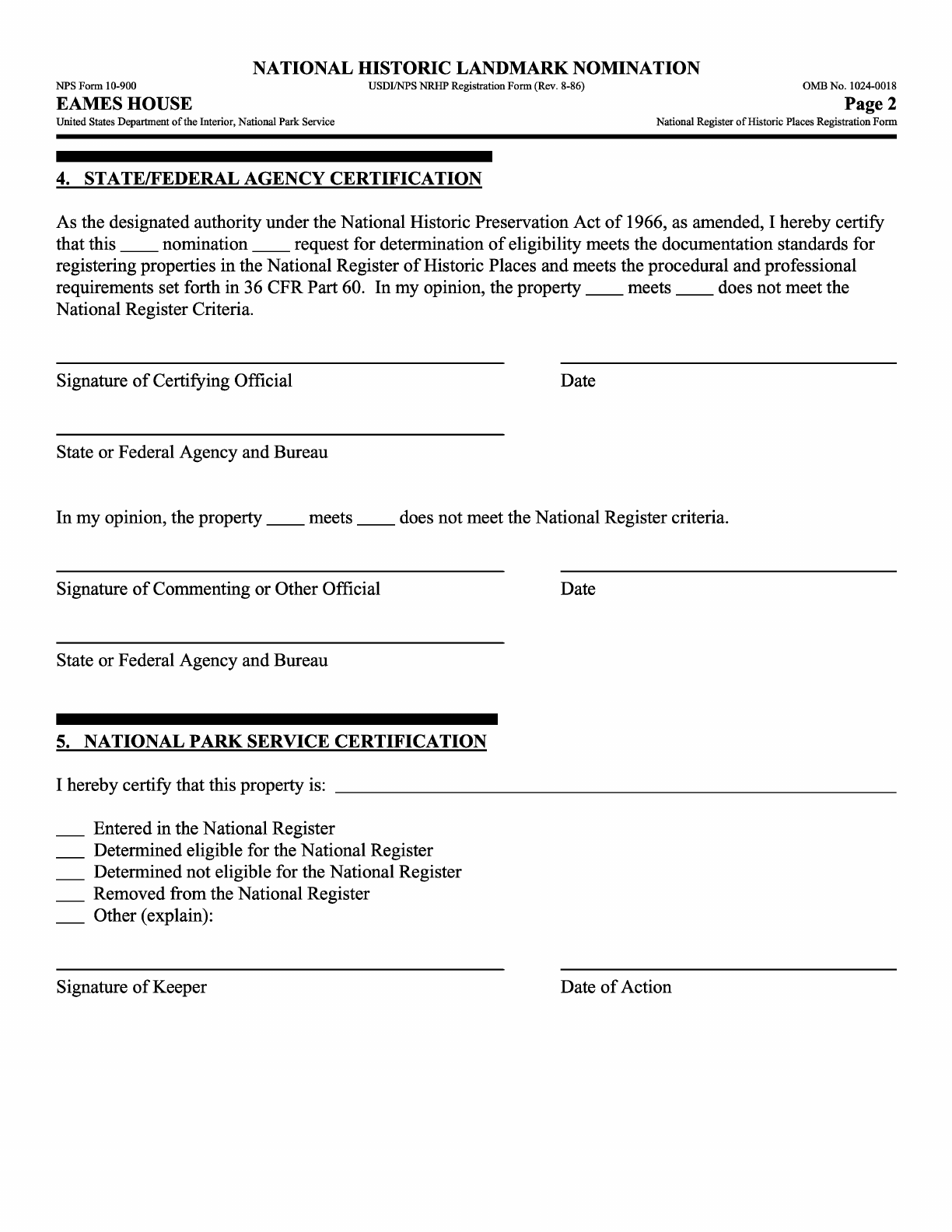
NATIONAL
HISTORIC
LANDMARK
NOMINATION
NFS
Form
10-900
USDI/NPS
NRHP
Registration
Form
(Rev.
8-86)
OMB
No.
1024-0018
EAMES
HOUSE Page
2
United
States
Department
of
the
Interior,
National
Park
Service
National
Register
of
Historic
Places
Registration
Form
4.
STATE/FEDERAL
AGENCY
CERTIFICATION
As
the
designated
authority
under
the
National
Historic
Preservation
Act
of
1966,
as
amended,
I
hereby
certify
that
this
__
nomination
__
request
for
determination
of
eligibility
meets
the
documentation
standards
for
registering
properties
in
the
National
Register
of
Historic
Places
and
meets
the
procedural
and
professional
requirements
set
forth
in
36
CFR
Part
60.
In
my
opinion,
the
property
__
meets
__
does
not
meet
the
National
Register
Criteria.
Signature
of
Certifying
Official
Date
State
or
Federal
Agency
and
Bureau
In
my
opinion,
the
property
__
meets
__
does
not
meet
the
National
Register
criteria.
Signature
of
Commenting
or
Other
Official
Date
State
or
Federal
Agency
and
Bureau
5.
NATIONAL
PARK
SERVICE
CERTIFICATION
I
hereby
certify
that
this
property
is:
Entered
in
the
National
Register
Determined
eligible
for
the
National
Register
Determined
not
eligible
for
the
National
Register
Removed
from
the
National
Register
Other
(explain):
Signature
of
Keeper
Date
of
Action
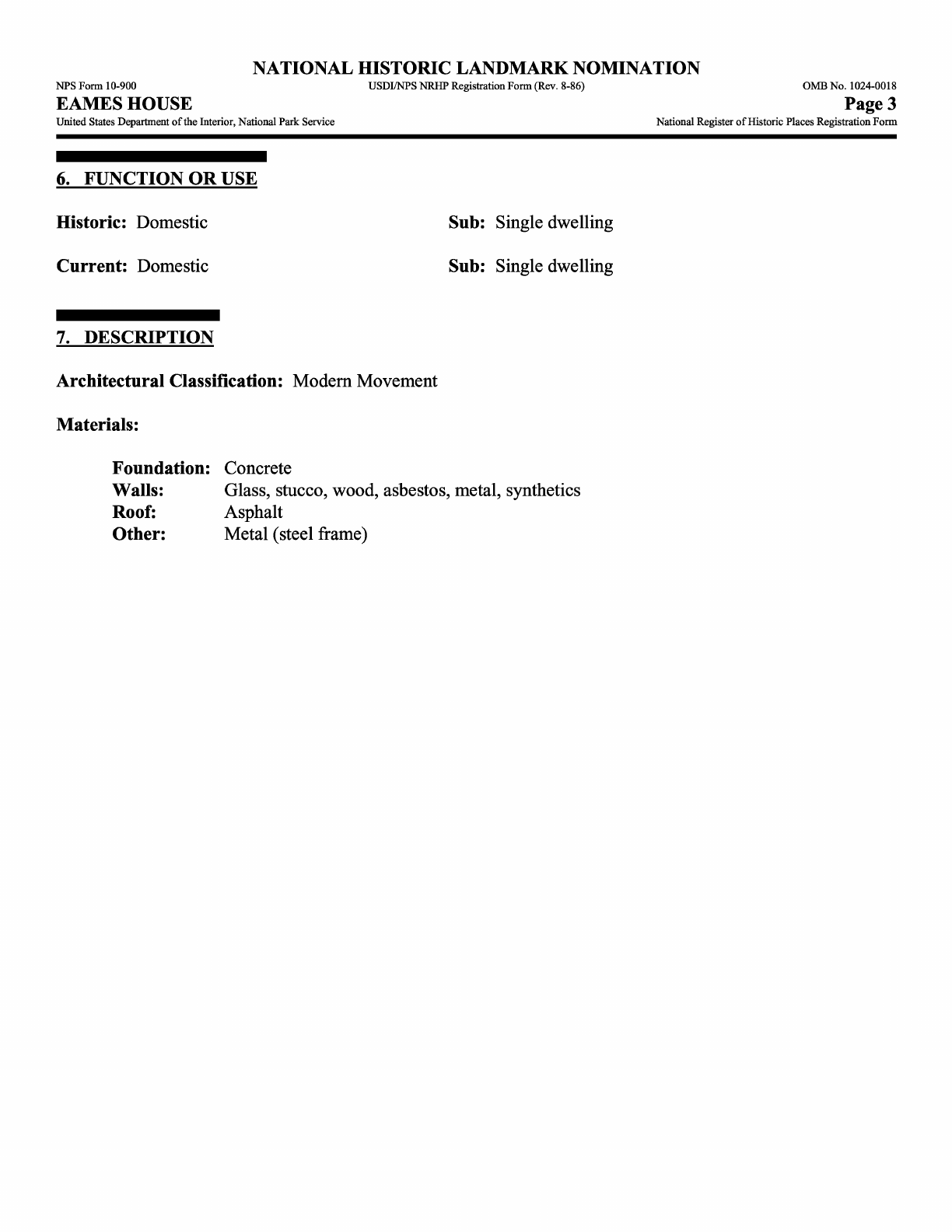
NFS
Form
10-900
EAMES
HOUSE
United
States
Department
of
the
Interior,
National
Park
Service
NATIONAL
HISTORIC
LANDMARK
NOMINATION
USDI/NPS
NRHP
Registration
Form
(Rev.
8-86)
OMB
No.
1024-0018
Page
3
National
Register
of
Historic
Places
Registration
Form
6.
FUNCTION
OR
USE
Historic:
Domestic
Current:
Domestic
Sub:
Single
dwelling
Sub:
Single
dwelling
7.
DESCRIPTION
Architectural
Classification:
Modern
Movement
Materials:
Foundation:
Concrete
Walls:
Glass,
stucco,
wood,
asbestos,
metal,
synthetics
Roof:
Asphalt
Other:
Metal
(steel
frame)

NATIONAL
HISTORIC
LANDMARK
NOMINATION
NFS
Form
10-900
USDI/NPS
MRHP
Registration
Form
(Rev.
8-86)
OMB
No.
1024-0018
EAMES
HOUSE Page
4
United
States
Department
of
the
Interior,
National
Park
Service
National
Register
of
Historic
Places
Registration
Form
Describe Present
and
Historic
Physical
Appearance
Location
The
Eames
House
is
located
in
the
Pacific
Palisades
area
of
Los
Angeles,
California.
The
property
is
composed
of
a
residence
and
studio
situated
on
a
bluff
overlooking
the
Pacific
Ocean.
The
residence and
studio
occupy
level
ground
at
the
base
of
a
steep
slope
along
the
western
edge
of
the
property.
The
community
of
Pacific
Palisades
sits
on
the
high
bluffs
along
the
Pacific Coast
between
the
cities
of
Santa
Monica and
Malibu.
Atop
the
bluffs,
flat
plateaus,
or
mesas,
are
defined
by
canyons
that
run inland
from
the
shoreline
cliffs.
The
broad
Santa
Monica
Canyon
divides
Pacific
Palisades from
the
City
of
Santa
Monica.
The
subject
property
occupies
a
lower
yet
distinct
plateau
on
the
northern
edge
of
Santa
Monica
Canyon,
overlooking
the
ocean
immediately
to
the
south.
The
mouth
of
the
canyon
is
located
on
marine
shales,
as
described
by
UCLA
geologist
Dr.
Richard
F.
Logan:
The
ever
threatening
cliff
that
overhangs
the Coast
Highway
at
Chautauqua
...
is
composed
entirely
of
slightly
consolidated
alluvium;
the
other
three
sides
all
involve
marine
shales,
which
become extremely
heavy
in
wet
years
through
absorption
of
rain
water,
and
simultaneously
become
greasy,
thus
lubricating
a
potential
massive
earth
movement.
The
major
part
of
Pacific
Palisades
is
free
of
all
danger
from
slides,
but
the
canyon
borders
and
sea-cliff
edge
present
some
serious
stabilization
problems.
l
The
Eames
House
is
located
within
a
cluster
of
four
single
family residences,
all
designed
as
part
of
the
Case
f\
Study
House
program.
The
property
is
not
visible
from
the
street,
and
is
accessed
via
a
private
drive
that
leads
from
Chautauqua
Boulevard.
A
sign
indicating
the
addresses
201
and
203
Chautauqua
is
posted
at
the
drive's
entrance.
The
asphalt
paved
drive
leads
first
to
the
property
at
201
Chautauqua
(The
Entenza
House,
Case
Study
House
#9),
and
terminates
at
the
Eames
property.
To
the
north,
the
drive
is
edged
by
a
serpentine
brick
wall
with
weeping
mortar.
The
wall
is
part
of
Richard
Neutra's
landscape
design
for
the
property
at
219
Chautauqua
(The
Bailey
House,
Case
Study
House
#20).
The
drive's
southern
edge
is
lined
with
a
wood
fence,
and
is
shaded
by
mature
trees
that
overhang
it.
The
Eames
House occupies an
irregularly-shaped
1.4-acre
site.
The
site
is
predominately
flat
with
a
steep
upward
slope
at
its
western
edge.
The
house
is
situated
parallel
to
the
slope
and
is
oriented
toward
a
grassy
area
to
the
east
known
as
"the
meadow."
The
property
is
densely
landscaped,
creating
a
sense
of
private
enclosure
and
separating
it
from
its
neighbors.
An earthen
mound,
or
berm,
is
situated
at
the
far
edge
of
the
property.
It
features
a
metal
fence
obscured
by
mature
shrubs,
providing
a
visual
screen
from
the
adjacent
Entenza
House.
Eucalyptus
trees
planted
along
the
eastern
elevations
of
the
house
provide added
privacy
and
shade.
A
wood
plank
pathway
leads
from
the
drive
and
runs
along
the
full
extent
of
the
house's
eastern
facade.
*Dr.
Richard
F.
Logan,
"Pacific
Palisades,
the
Natural
Setting,"
Pacific
Palisades,
Where
the
Mountains
Meet
the
Sea, ed.
Betty
Lou
Young.
(Pacific
Palisades,
CA:
Pacific
Palisades
Historical
Society
Press,
1983),
2.
2
Other
houses
within
this
cluster
include
Case
Study
House
#18
(199
Chautauqua
Boulevard);
Case
Study
#9
(201
Chautauqua
Boulevard);
and
Case
Study
House
#20 (219
Chautauqua
Boulevard).

NATIONAL
HISTORIC
LANDMARK
NOMINATION
NFS
Form
10-900
USDI/NPS
NRHP
Registration
Form
(Rev.
8-86)
OMB
No.
1024-0018
EAMES
HOUSE Page
5
United
States
Department
of
the
Interior,
National
Park
Service
National
Register
of
Historic
Places
Registration
Form
Design
and
Construction
The
Eames
House
is
composed
of
two
distinct
volumes,
a
living
component
(or
residence)
and
a
working
component
(or
studio).
The
two
volumes
are
arranged
in
a
linear
configuration
and
separated
by
an
open
court.
Both
volumes
are
rectangular
in
plan
with
horizontal
massing,
and
are
situated along
the
western
edge
of
the
property.
The
residence
is
1,500
square
feet,
with
the
studio
containing
an
additional
1,000
square
feet.
The
Eames
House
is
modular
in
its
design,
composed
of
20'
x
7'
4"
bays
that
rise
to
a
height
of
17
feet.
Each
bay
is
defined
by
a
steel
frame
consisting
of
two
rows
of
4-inch H-columns
set
20
feet
apart,
with
a
12-inch
open-web
joist
forming
the
top
member.
On
the
rear
(west)
elevation,
the
vertical
member
of
each
frame
is
partially
embedded
in
an
8-foot
high
poured
concrete
retaining
wall
at
the
base
of
the
slope
that
forms
the
lower
part
of
the
west
elevation
in
both
components.
Steel
decking
running
perpendicular
to
the
frames
forms
the
o
underside
of
the
flat
roof.
The
roof
is
a
gravel
surfaced,
built-up
assembly.
The
20-foot
wide
dimension
of
the
frames
define
the
width
of
both
the
residence
and
studio.
The
residence
consists
of
eight
bays, and
the
studio
is
five
bays
wide.
The
open
court
that
separates
the
two structures
is
the
equivalent
of
four
bays
in
width.
The
exposed
steel
frames
are
painted
black,
which
visually
delineates
each
bay
and
the
shared
structural
rhythm
of
the
two
components.
Diagonal cross-bracing,
composed
of
metal
cables
visible
on
the
exterior,
provides
structural
stability
for
the
frames.
Each
bay
is
in-filled with
one
of
several
materials,
including
panels
of
plaster, plywood,
asbestos,
glass,
and
"pylon"
(a
translucent
laminate
similar
to
fiberglass).
4
Some
bays
contain
one
type
of
infill
material,
such
as
a
single
plaster
panel.
Other
bays
are
divided
into
multiple
smaller
panels
of
uniform
dimension,
with
up
to
twelve
in
the
lower
story
(two
rows
of
six),
and
as
many
as
fourteen
in
the
upper
story
(two
rows
of
seven).
Like the
frames,
the
steel
sashes
and
sub-dividers
are
also
painted
black,
creating
a
horizontal
grid
pattern.
Plaster
panels
are
painted
black,
white,
beige,
red,
or
blue.
The
main
entrance
to
the
residence
is
located
on
the
primary
(east)
fagade.
The
hinged
door
is
off-set
right
of
center
in
elevation
and
consists
of
five
translucent
glazed
panels
that
echo
the
size
and appearance
of
the
panels
that
flank
the
door
to
the
right
and
directly
above.
Two
small
panels
located
above
and
spanning
the entire
width
of
the
entry
bay
frame
are
highlighted
in
gold.
A
rotating
black-glazed
ceramic
bell,
attributed
to
Mexican
potter,
Maria
Martinez,
flanks
the
main
entrance
to
the
right.
The
inner
portion
of
the
two
rectangular
volumes
(i.e.
the
northern
portion
of
the
residence,
and
southern
portion
of
the
studio),
are
each
divided
into
an
upper
and
lower
story,
with
additional
open-web
joists
at
a
height
of
8
feet.
The
outer portions
(i.e.
the
southern
portion
of
the
residence,
and
northern
portion
of
the
studio),
are
open
to
form
double-height interior
spaces.
A
deep
overhang
and
the
rear
wall
extend
beyond
the
south
faQade
of
the
residence, creating
another
outdoor
space.
5
Windows
include
both
fixed
and
operable
awning
casements
divided
into
two
horizontal
lights.
Windows
and
doors
are
glazed
with
a
combination
of
transparent
and translucent
glass.
Wire-reinforced
glass
is
used
in
some
bays
of
the
studio.
The
north,
east,
and
south
elevations
of
both
the
residence
and
studio
contain
large
areas
of
3
According
to
staff
at
the
Eames
Foundation,
gravel
surface
tar
paper
covers
one-half
inch insulation
on
the
roof
of
both
components.
4
James
Steele,
Eames
House,
Charles
and
Ray
Eames
(London:
Phaidon
Press
Limited,
1994),
10.
5
"Case
Study
House
for
1949:
The
Steel
Frame,"
Arts
&
Architecture
(March
1949),
30-31.
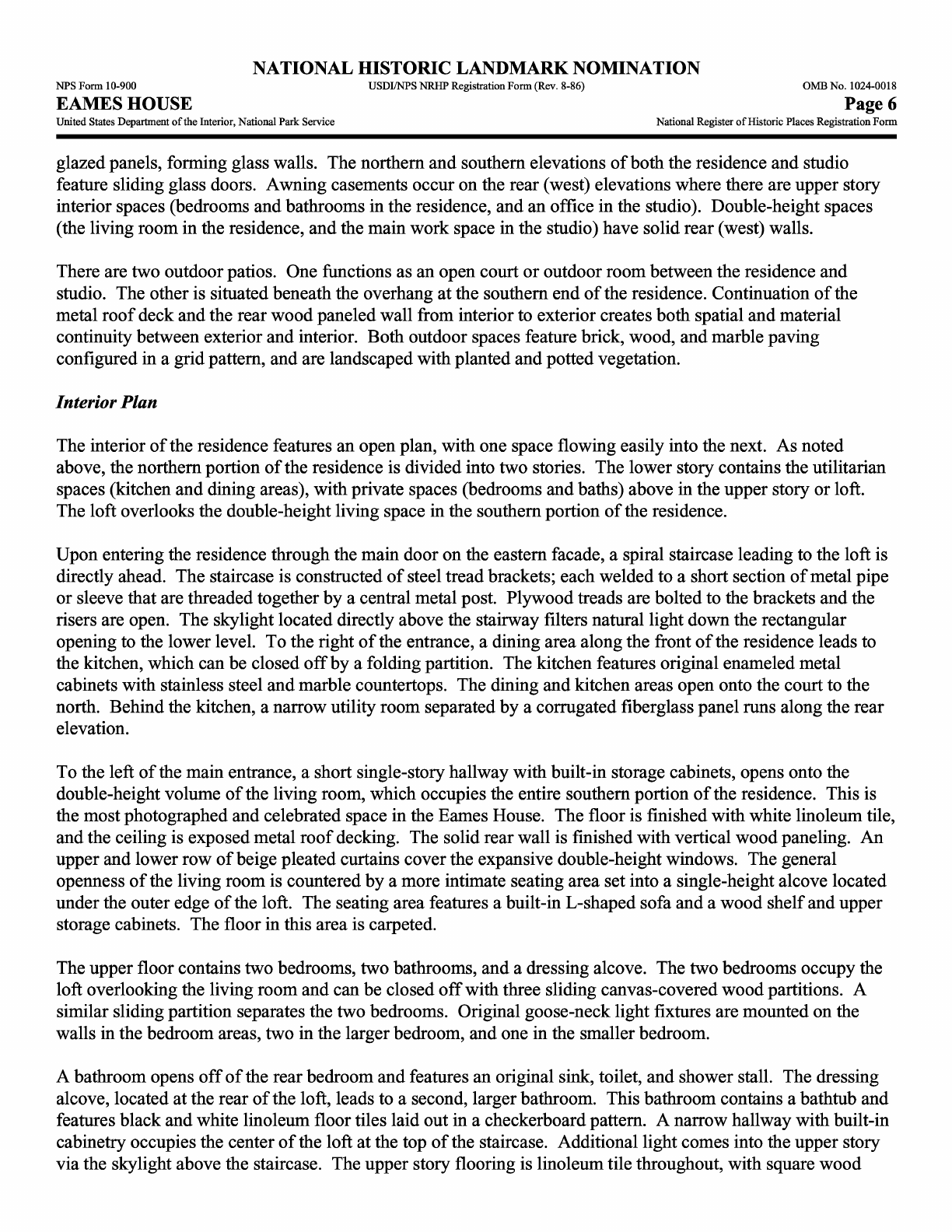
NATIONAL
HISTORIC
LANDMARK
NOMINATION
NFS
Form
10-900
USDI/NPS
NRHP
Registration
Form
(Rev.
8-86)
OMB
No.
1024-0018
EAMES
HOUSE Page
6
United
States
Department
of
the
Interior,
National
Park
Service
National
Register
of
Historic
Places
Registration
Form
glazed
panels,
forming
glass
walls.
The
northern
and
southern
elevations
of
both
the
residence
and
studio
feature
sliding
glass
doors.
Awning
casements
occur
on
the
rear
(west)
elevations
where
there
are
upper
story
interior
spaces
(bedrooms
and
bathrooms
in
the
residence,
and
an
office
in
the
studio).
Double-height
spaces
(the
living
room
in
the
residence,
and
the
main
work
space
in
the
studio)
have
solid
rear
(west)
walls.
There
are
two
outdoor
patios.
One
functions
as
an
open
court
or
outdoor
room
between
the
residence
and
studio.
The
other
is
situated
beneath
the
overhang
at
the
southern
end
of
the
residence.
Continuation
of
the
metal
roof
deck
and
the
rear
wood
paneled
wall
from
interior
to
exterior
creates
both
spatial
and
material
continuity
between
exterior
and
interior.
Both
outdoor
spaces feature
brick, wood,
and
marble
paving
configured
in
a
grid
pattern,
and
are
landscaped
with
planted
and
potted
vegetation.
Interior
Plan
The
interior
of
the
residence
features
an
open
plan,
with
one
space
flowing
easily
into
the
next.
As
noted
above,
the
northern
portion
of
the
residence
is
divided
into
two
stories. The
lower
story
contains
the
utilitarian
spaces
(kitchen
and
dining
areas),
with
private
spaces
(bedrooms
and
baths)
above
in
the
upper
story
or
loft.
The
loft
overlooks
the
double-height
living
space
in
the
southern
portion
of
the
residence.
Upon
entering
the
residence
through
the
main door
on
the
eastern
facade,
a
spiral
staircase
leading
to
the loft
is
directly
ahead.
The
staircase
is
constructed
of
steel
tread
brackets;
each
welded
to
a
short
section
of
metal
pipe
or
sleeve
that
are
threaded together
by
a
central
metal
post.
Plywood
treads
are
bolted
to
the
brackets
and
the
risers
are open.
The
skylight
located
directly
above
the
stairway
filters
natural
light
down
the
rectangular
opening
to
the
lower
level.
To
the
right
of
the
entrance,
a
dining area
along
the
front
of
the
residence
leads
to
the
kitchen,
which
can
be
closed
off
by
a
folding
partition.
The
kitchen
features
original
enameled
metal
cabinets
with
stainless
steel
and
marble
countertops.
The
dining and
kitchen
areas
open
onto
the
court
to
the
north.
Behind
the
kitchen,
a
narrow
utility
room
separated
by
a
corrugated
fiberglass
panel
runs
along
the
rear
elevation.
To
the
left
of
the
main
entrance,
a
short
single-story
hallway
with built-in
storage
cabinets,
opens
onto
the
double-height
volume
of
the
living
room,
which
occupies
the
entire
southern
portion
of
the
residence.
This
is
the
most
photographed
and
celebrated
space
in
the
Eames
House. The
floor
is
finished
with
white linoleum
tile,
and
the
ceiling
is
exposed
metal
roof
decking.
The
solid
rear
wall
is
finished
with
vertical
wood
paneling.
An
upper
and
lower
row
of
beige
pleated
curtains
cover
the
expansive
double-height
windows.
The
general
openness
of
the
living
room
is
countered
by
a
more
intimate
seating area
set
into
a
single-height
alcove
located
under
the
outer
edge
of
the
loft.
The
seating
area
features
a
built-in
L-shaped
sofa
and
a
wood
shelf
and
upper
storage
cabinets.
The
floor
in
this
area
is
carpeted.
The
upper
floor
contains
two
bedrooms,
two
bathrooms,
and
a
dressing
alcove.
The
two
bedrooms
occupy
the
loft
overlooking
the
living
room
and
can
be
closed
off
with
three
sliding
canvas-covered
wood
partitions.
A
similar
sliding
partition
separates the
two
bedrooms.
Original
goose-neck
light
fixtures
are
mounted
on
the
walls
in
the
bedroom
areas,
two
in
the
larger
bedroom,
and
one
in
the
smaller
bedroom.
A
bathroom
opens
off
of
the
rear
bedroom
and
features
an
original
sink,
toilet,
and
shower
stall.
The
dressing
alcove,
located
at
the
rear
of
the
loft,
leads
to
a
second,
larger
bathroom.
This
bathroom
contains
a
bathtub
and
features
black
and
white linoleum
floor
tiles
laid
out
in
a
checkerboard
pattern.
A
narrow
hallway
with built-in
cabinetry
occupies
the
center
of
the loft
at
the
top
of
the
staircase.
Additional
light
comes
into
the
upper
story
via
the
skylight
above
the
staircase.
The
upper
story
flooring
is
linoleum
tile
throughout,
with
square
wood

NATIONAL
HISTORIC
LANDMARK
NOMINATION
NFS
Form
10-900
USDI/NPS
NRHP
Registration
Form
(Rev.
8-86)
OMB
No.
1024-0018
EAMES
HOUSE Page
7
United
States
Department
of
the
Interior,
National
Park
Service
National
Register
of
Historic
Places
Registration
Form
panels
finishing
the
interior
walls.
Upstairs
windows
feature
horizontal
sliding
shades
composed
of
fiberglass
panels
in
wood
frames.
The
studio
building
also
features
an
open
plan.
As
in
the
residence,
a
portion
of
the
studio
is
divided
into
two
stories,
with
an
upper
loft overlooking
a
double-height
space.
Here,
the
southern
portion
of
the
studio
has two
levels.
The
ground
level
contains
a
kitchen
along
the
east
elevation,
with
a
powder
room
and
hallway
beyond.
An
enclosed
room
situated
to
the
rear
is
used
for
storage.
The
kitchen
looks
onto
the
open
court
to
the
south.
The
loft
contains
a
single
work
space
and
overlooks
a
double-height
studio
area
to
the
north.
The
upper
story
is
accessed via
an
open
steel
staircase
with
wood
treads,
open risers,
and
simple
pipe
handrails.
The
floors
are
wood
parquet
on
the
first
story
with
linoleum
tile upstairs.
The
ceiling
is
exposed
metal
roof
decking.
Additional
fiberglass
horizontal
sliding
shades
cover
the
multiple
windows
throughout.
Material
Integrity
The
Eames
House
retains
an
extraordinarily
high
degree
of
material
integrity,
and
ably
conveys
its
association
with
the
Case
Study
House
program
and
with
Charles
and
Ray
Eames.
In
all
seven
aspects
of
integrity,
the
property
is
remarkably
intact
and
true to
its
historic
design.
The
house
itself
is
situated
in
its
original
location
on
the
property.
Its
setting
is
generally
unchanged
from
its
original
appearance
with
the
exception
of
the
maturation
of
foliage.
All
major
elements
of
the
original landscape
design
are
extant,
including
the
grassy
ground
cover,
stands
of
eucalyptus
trees,
constructed
berm,
and
pedestrian
and
vehicular
pathways.
All
of
these
features
contribute
to
the
setting
of
the
Eames
House.
The
integrity
of
the
residence
and
studio
buildings
themselves
is
exceptionally
high.
The
workmanship
and
materials
are
intact.
The
house
has
been
well-maintained
with
little
need
for
substantial
repairs
or
replacements.
The
interior
spaces
appear
much
as
they
did
when
the
Eameses
lived
and
worked
in
them.
The
furnishings,
objects,
and
decoration
in
the
house
are
seen
today
just
as
they
were
in
the
many
photographs
through
which
the owners
exhaustively
interpreted
and
documented
the
property
during
their
years
of
residence.
Few
historic
properties
have
maintained
the
integrity
of
feeling
and
association evident
at
the
Eames
House.
This
is
largely
due
to
the
dedicated
and
ongoing
stewardship
of
the
family
that originally
designed
and
built
it.
The
association
of
the
property
with
Charles
and
Ray
Eames,
with
the
Case
Study
House
program,
and
with
its
own role in
Modern
domestic
architecture
in
the
United
States
is
very
strong.
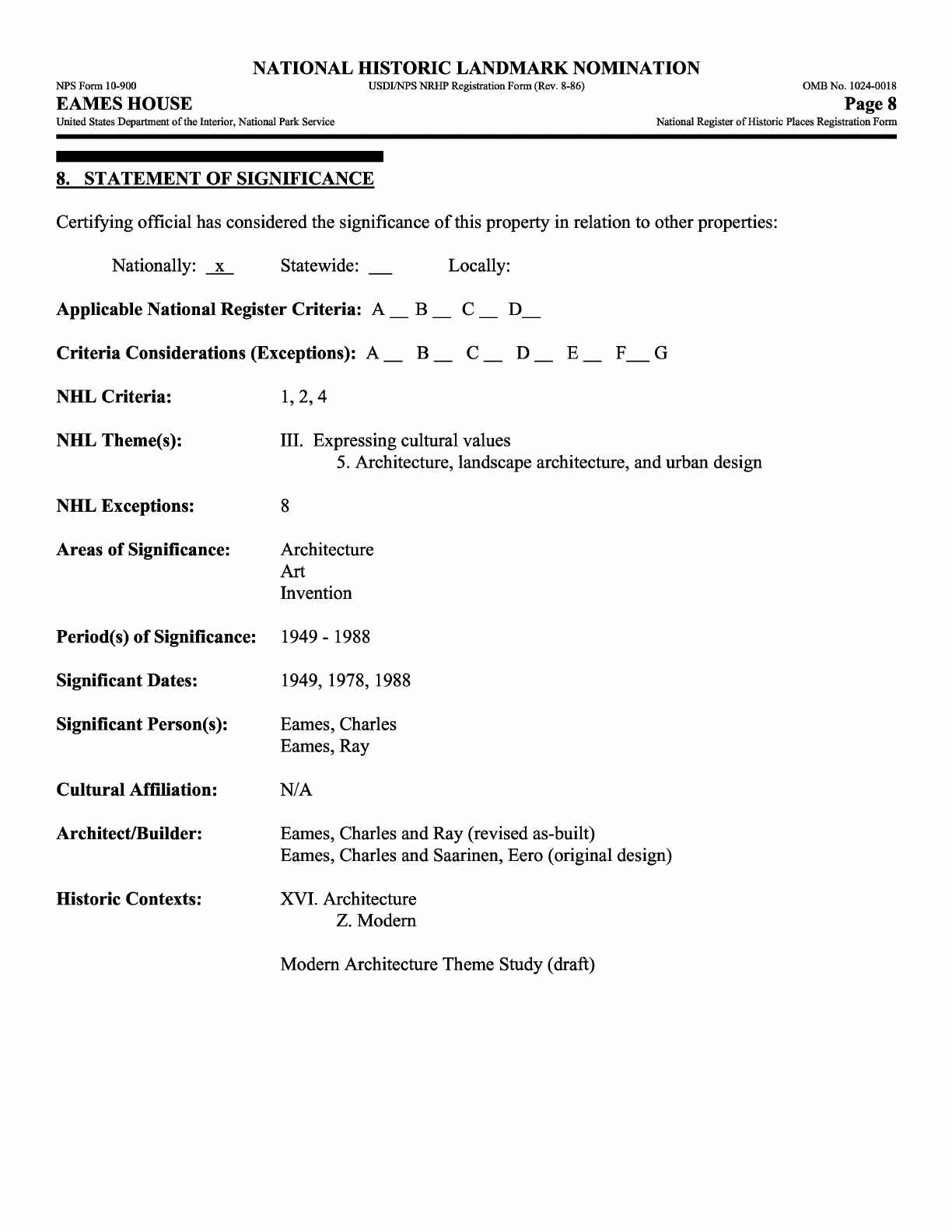
NATIONAL
HISTORIC
LANDMARK
NOMINATION
NFS
Form
10-900
USDI/NPS
NRHP
Registration
Form
(Rev.
8-86)
OMB
No.
1024-0018
EAMES
HOUSE Page
8
United
States
Department
of
the
Interior,
National
Park
Service
National
Register
of
Historic
Places
Registration
Form
8.
STATEMENT
OF
SIGNIFICANCE
Certifying
official
has
considered
the
significance
of
this
property
in
relation
to
other
properties:
Nationally:
x
Statewide:
_
Locally:
Applicable
National
Register
Criteria:
A
_
B
_
C
_
D_
Criteria
Considerations
(Exceptions):
A
_
B
_
C
_
D
_
E
_
F_
G
NHL
Criteria:
1,2,4
NHL
Theme(s):
III.
Expressing
cultural values
5.
Architecture,
landscape
architecture, and
urban design
NHL
Exceptions:
8
Areas
of
Significance:
Architecture
Art
Invention
Period(s)
of
Significance:
1949
-1988
Significant
Dates:
1949, 1978,
1988
Significant
Person(s):
Eames, Charles
Eames,
Ray
Cultural
Affiliation:
N/A
Architect/Builder:
Eames,
Charles
and
Ray
(revised
as-built)
Eames,
Charles
and
Saarinen,
Eero
(original
design)
Historic
Contexts:
XVI.
Architecture
Z.
Modern
Modern
Architecture
Theme Study
(draft)

NATIONAL
HISTORIC
LANDMARK
NOMINATION
NFS
Form
10-900
USDI/NPS
MRHP
Registration
Form
(Rev.
8-86)
OMB
No.
1024-0018
EAMES
HOUSE Page
9
United
States
Department
of
the
Interior,
National
Park
Service
National
Register
of
Historic
Places
Registration
Form
State
Significance
of
Property,
and
Justify
Criteria,
Criteria
Considerations,
and
Areas
and
Periods
of
Significance
Noted
Above.
Summary
The
Eames
House
is
eligible
for
designation
as
a
National
Historic
Landmark
under
Criterion
#1
for
its
association
with
the
Case
Study
House
program
and
the
Modern
architecture
movement
in
the
United
States;
under
Criterion
#2
for
its
association
with
influential
designers
Charles
and Ray
Eames;
and
under
Criterion
#4
as
an
exceptionally
important
work
of
postwar
Modern
residential
design
and
construction.
The
Eames House,
Case
Study
House
#8,
is
the
most recognizable
and
most widely
published
of
all
the
residences
completed within
the
Case
Study
House program.
The
program
was
unique
in
the
nation
for
its
concerted
efforts
to
introduce
Modern
domestic
architecture
to
the
broader
public
in
the
period
after
World
War
II.
The
Eames
House
best
represents
the
goals
and
ideals
of
the
Case
Study
House program.
The
Eames
House
is
the
property
most
closely
associated
with
nationally-significant
designers
Charles
and
Ray
Eames.
The
property
served
as
their
private residence
and
working
studio
throughout
their
prolific
careers
as
furniture
designers,
filmmakers,
photographers,
exhibition
designers,
and
graphic
artists.
Charles
and Ray
occupied
the
house
from
the
completion
of
its
construction
in
1949
until
their
deaths
in
1978
and
1988,
respectively.
The
Eames
House
is
one
of
the
few
architectural
works
attributed
to
Charles
Eames,
and
embodies
many
of
the
distinguishing
characteristics
and
ideals
of
postwar
Modernism
in
the
United
States.
Since
the time
of
its
construction,
the
Eames
House
has
been
regarded
as
one
of
the
most
significant
experiments
in
American
domestic architecture.
The
period
of
significance
for
the
Eames
House
coincides
with
the
residency
of
its
designers,
extending
from
1949
until
1988.
John
Entenza
and
Arts
&
Architecture
Magazine
The
lineage
of
Arts
&
Architecture
magazine
dates
back
to
1911
and
a
publication entitled
Pacific
Builder.
Later renamed
California
Arts
&
Architecture,
the
magazine
was
regional
in
its
focus.
Not
considered
culturally
or
artistically
progressive,
the
magazine
emphasized
traditional
arts,
interior
design,
domestic
architecture,
and
gardening.
In
1938,
John
Entenza
purchased
California
Arts
&
Architecture.
Though
he
did
not
have
a
background
in
publishing,
Entenza
had
long
cultivated
an
interest
in
architecture.
6
Two
years
later,
he
would
become
the
magazine's
editor and
shift
its
focus
from
regional
art
to
internationally-recognized
movements
in
modernist
art
and
architecture.
To
communicate
this
new
direction,
Entenza
commissioned
graphic
artists
Herbert Matter
and
Alvin
Lustig
to
redesign
the
magazine's
graphics,
and
format.
The
newly
revamped
California
Arts
&
Architecture
debuted
in
February
of
1942,
with
the
word "California"
graphically
de-emphasized
on
the
cover
and
later
dropped
entirely
in
1944.
6
The
previous
year,
Entenza
had
commissioned
Los
Angeles
architect
Harwell
Hamilton
Harris
to
design
his
private
residence.
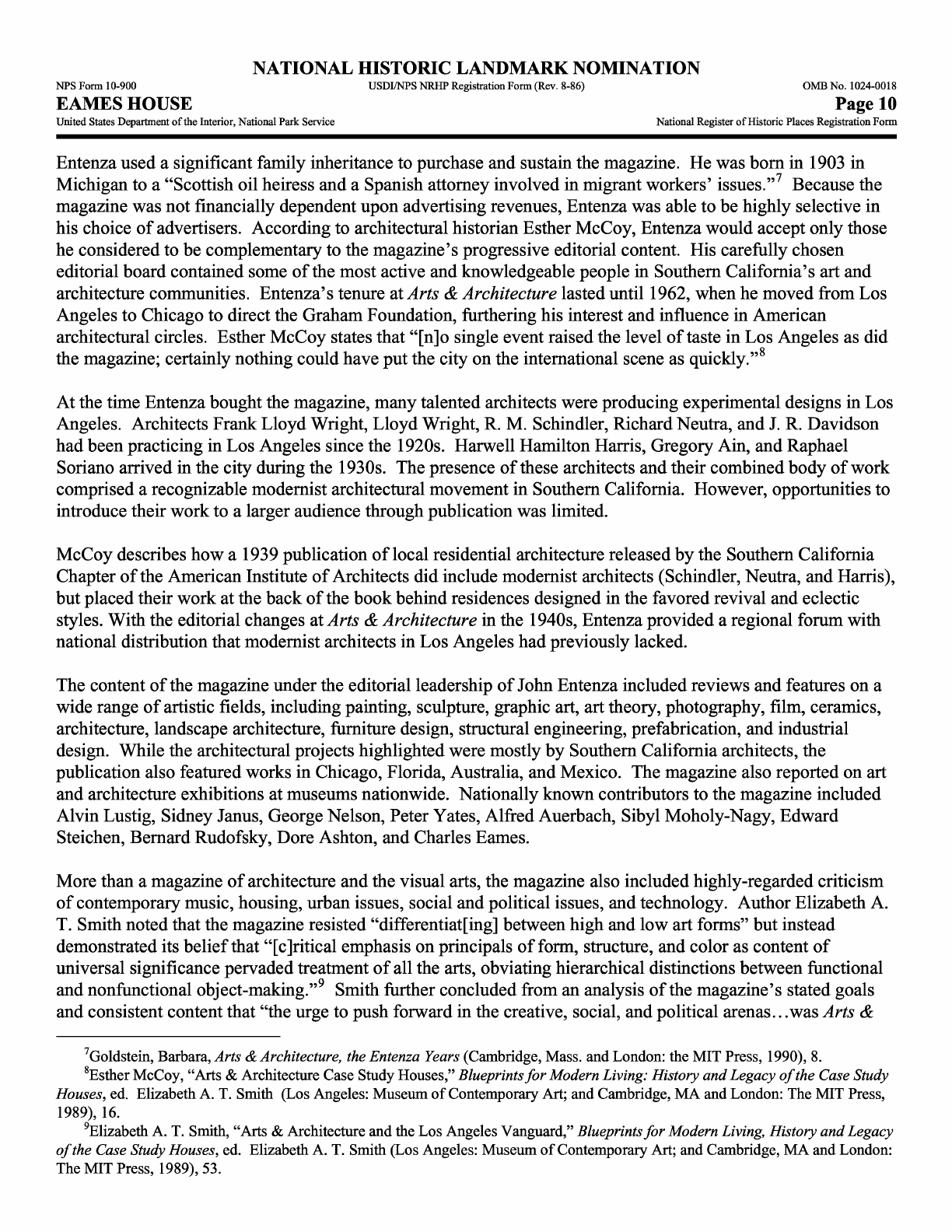
NATIONAL
HISTORIC
LANDMARK
NOMINATION
NFS
Form
10-900
USDI/NPS
MRHP
Registration
Form
(Rev.
8-86)
OMB
No.
1024-0018
EAMES
HOUSE
Page
10
United
States
Department
of
the
Interior,
National
Park
Service
National
Register
of
Historic
Places
Registration
Form
Entenza
used
a
significant
family
inheritance
to
purchase
and
sustain the magazine.
He
was
born
in
1903
in
Michigan
to
a
"Scottish
oil
heiress
and
a
Spanish
attorney involved
in
migrant
workers'
issues."
7
Because
the
magazine
was
not
financially
dependent
upon
advertising
revenues,
Entenza
was
able
to
be
highly
selective
in
his choice
of
advertisers.
According
to
architectural
historian
Esther
McCoy,
Entenza
would
accept
only those
he
considered
to
be
complementary
to
the
magazine's
progressive
editorial
content.
His
carefully
chosen
editorial
board
contained
some
of
the
most
active
and
knowledgeable
people
in
Southern
California's
art
and
architecture
communities.
Entenza's
tenure
at
Arts
&
Architecture
lasted
until
1962,
when
he
moved
from
Los
Angeles
to
Chicago
to
direct
the
Graham
Foundation, furthering
his
interest
and
influence
in
American
architectural
circles.
Esther
McCoy
states
that
"[n]o
single
event
raised
the
level
of
taste
in
Los
Angeles
as
did
the
magazine;
certainly
nothing
could have
put
the
city
on
the
international
scene
as
quickly."
8
At
the
time
Entenza
bought
the
magazine,
many
talented
architects
were
producing
experimental
designs
in
Los
Angeles.
Architects
Frank
Lloyd
Wright,
Lloyd
Wright,
R.
M.
Schindler,
Richard
Neutra,
and
J.
R.
Davidson
had
been
practicing
in
Los
Angeles
since
the
1920s.
Harwell Hamilton
Harris,
Gregory
Ain,
and
Raphael
Soriano
arrived
in
the
city
during the
1930s.
The
presence
of
these
architects
and
their
combined
body
of
work
comprised
a
recognizable
modernist
architectural
movement
in
Southern
California.
However,
opportunities
to
introduce
their
work
to
a
larger
audience
through
publication
was
limited.
McCoy
describes
how
a
1939
publication
of
local
residential
architecture
released
by
the
Southern
California
Chapter
of
the
American
Institute
of
Architects
did
include
modernist
architects
(Schindler,
Neutra,
and
Harris),
but
placed
their
work
at
the
back
of
the
book
behind
residences
designed
in
the
favored
revival
and
eclectic
styles.
With
the
editorial
changes
at
Arts
&
Architecture
in
the
1940s,
Entenza
provided
a
regional
forum
with
national
distribution
that
modernist
architects
in
Los
Angeles
had
previously
lacked.
The
content
of
the
magazine
under
the
editorial
leadership
of
John
Entenza included
reviews
and
features
on
a
wide
range
of
artistic
fields,
including
painting,
sculpture,
graphic
art,
art
theory,
photography,
film,
ceramics,
architecture, landscape
architecture, furniture
design,
structural engineering,
prefabrication,
and
industrial
design.
While the
architectural
projects
highlighted
were
mostly
by
Southern
California
architects,
the
publication
also
featured
works
in
Chicago, Florida,
Australia,
and
Mexico.
The
magazine
also
reported
on
art
and
architecture
exhibitions
at
museums
nationwide.
Nationally
known
contributors
to
the
magazine
included
Alvin
Lustig, Sidney Janus,
George
Nelson,
Peter
Yates,
Alfred
Auerbach,
Sibyl
Moholy-Nagy,
Edward
Steichen,
Bernard
Rudofsky,
Dore
Ashton,
and
Charles
Eames.
More
than
a
magazine
of
architecture
and
the
visual
arts,
the
magazine
also
included
highly-regarded
criticism
of
contemporary
music,
housing,
urban
issues, social
and
political
issues,
and technology.
Author
Elizabeth
A.
T.
Smith
noted
that
the
magazine
resisted
"differentiat[ing]
between
high
and
low
art
forms"
but
instead
demonstrated
its
belief
that "[c]ritical
emphasis
on
principals
of
form,
structure,
and
color
as
content
of
universal
significance
pervaded
treatment
of
all
the
arts,
obviating
hierarchical
distinctions
between
functional
and
nonfunctional
object-making."
9
Smith
further
concluded
from
an
analysis
of
the
magazine's
stated
goals
and
consistent
content
that
"the
urge
to
push
forward
in
the
creative,
social,
and
political
arenas..
.was
Arts
&
7
Goldstein,
Barbara,
Arts
&
Architecture,
the
Entenza
Years
(Cambridge,
Mass,
and
London:
the
MIT
Press,
1990),
8.
8
Esther
McCoy,
"Arts
&
Architecture
Case
Study
Houses,"
Blueprints
for
Modern
Living:
History
and
Legacy
of
the Case
Study
Houses,
ed.
Elizabeth
A.
T.
Smith (Los
Angeles:
Museum
of
Contemporary
Art;
and Cambridge,
MA
and
London:
The
MIT
Press,
1989),
16.
9
Elizabeth
A.
T.
Smith,
"Arts
&
Architecture and
the
Los
Angeles
Vanguard,"
Blueprints
for
Modern
Living,
History
and
Legacy
of
the
Case
Study
Houses,
ed.
Elizabeth
A.
T.
Smith (Los
Angeles:
Museum
of
Contemporary
Art;
and Cambridge,
MA
and
London:
The
MIT
Press,
1989),
53.
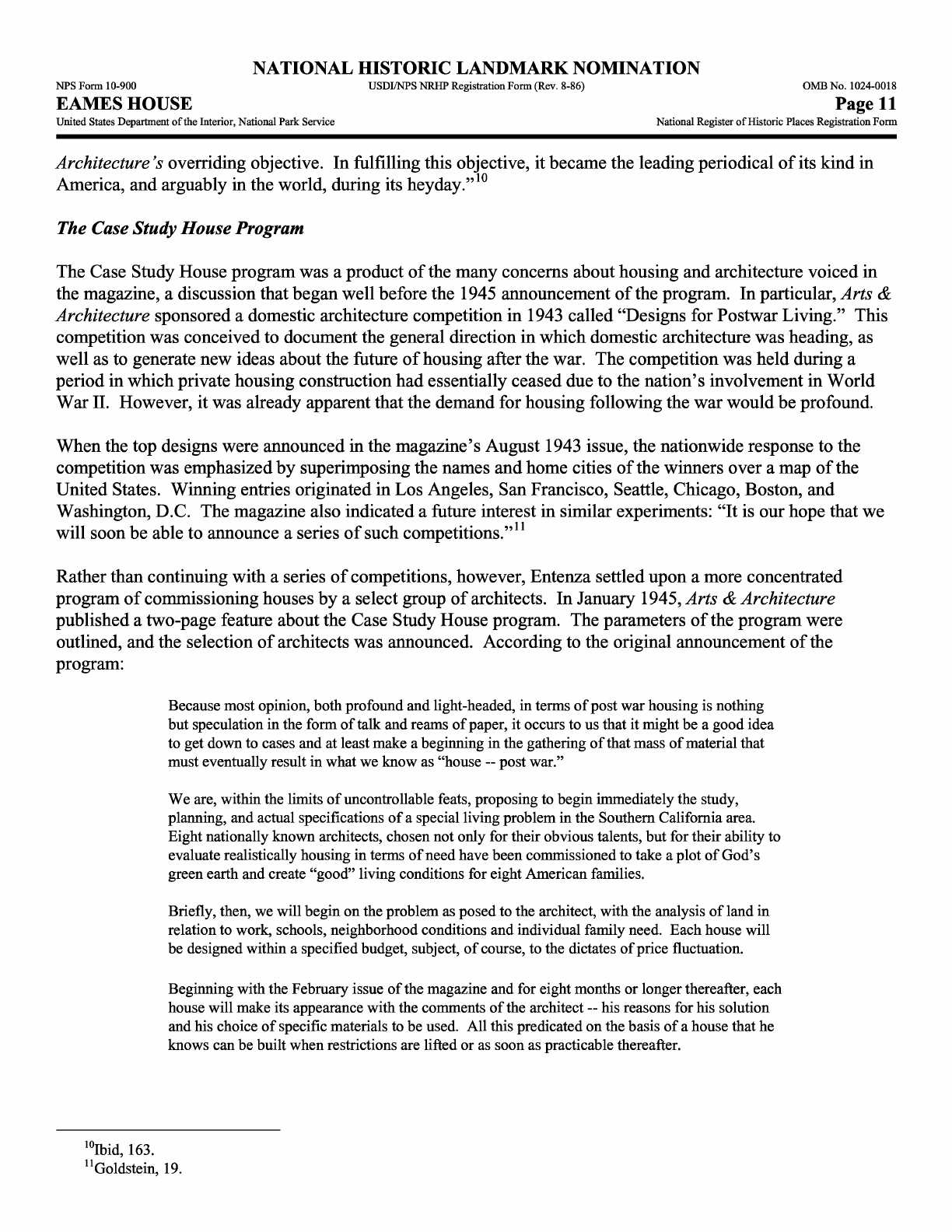
NATIONAL
HISTORIC
LANDMARK
NOMINATION
NFS
Form
10-900
USDI/NPS
NRHP
Registration
Form
(Rev.
8-86)
OMB
No.
1024-0018
EAMES
HOUSE
Page
11
United
States
Department
of
the
Interior,
National
Park
Service
National
Register
of
Historic
Places
Registration
Form
Architecture's
overriding
objective.
In
fulfilling
this
objective,
it
became
the
leading
periodical
of
its
kind
in
America, and
arguably
in
the
world, during
its
heyday."
10
The
Case
Study
House
Program
The
Case
Study
House
program
was
a
product
of
the
many
concerns
about
housing
and
architecture
voiced
in
the
magazine,
a
discussion
that
began
well
before
the
1945
announcement
of
the
program.
In
particular,
Arts
&
Architecture
sponsored
a
domestic
architecture
competition
in
1943
called
"Designs
for
Postwar Living."
This
competition
was
conceived
to
document
the
general
direction
in
which
domestic
architecture
was
heading,
as
well
as
to
generate
new
ideas
about
the
future
of
housing
after
the
war.
The
competition
was
held
during
a
period
in
which
private
housing
construction
had
essentially
ceased
due
to
the
nation's
involvement
in
World
War
II.
However,
it
was
already
apparent
that
the
demand
for
housing
following
the
war
would
be
profound.
When
the
top
designs
were
announced
in
the
magazine's
August
1943
issue,
the
nationwide
response
to
the
competition
was
emphasized
by
superimposing
the
names
and
home
cities
of
the
winners
over
a
map
of
the
United
States.
Winning
entries
originated
in
Los
Angeles,
San
Francisco,
Seattle,
Chicago,
Boston,
and
Washington,
D.C.
The
magazine
also
indicated
a
future
interest
in
similar
experiments:
"It
is
our
hope
that
we
will
soon
be
able
to
announce
a
series
of
such
competitions."
11
Rather than
continuing
with
a
series
of
competitions,
however,
Entenza
settled
upon
a
more
concentrated
program
of
commissioning
houses
by
a
select
group
of
architects.
In
January
1945,
Arts
&
Architecture
published
a
two-page
feature
about
the
Case
Study
House program.
The
parameters
of
the
program
were
outlined,
and
the
selection
of
architects
was
announced.
According
to
the
original
announcement
of
the
program:
Because
most
opinion,
both profound
and
light-headed,
in
terms
of
post
war
housing
is
nothing
but
speculation
in
the
form
of
talk
and
reams
of
paper,
it
occurs
to
us
that
it
might
be
a
good
idea
to
get
down
to
cases
and
at
least
make
a
beginning
in
the
gathering
of
that
mass
of
material
that
must
eventually
result
in
what
we
know
as
"house
~
post
war."
We
are,
within
the
limits
of
uncontrollable
feats,
proposing
to
begin
immediately
the
study,
planning,
and
actual
specifications
of
a
special
living
problem
in
the
Southern
California
area.
Eight
nationally
known
architects,
chosen
not
only
for
their
obvious
talents,
but
for
their
ability
to
evaluate
realistically
housing
in
terms
of
need
have
been
commissioned
to
take
a
plot
of
God's
green
earth
and
create
"good"
living
conditions
for
eight
American
families.
Briefly,
then,
we
will
begin
on
the
problem
as
posed
to
the
architect,
with
the
analysis
of
land
in
relation
to
work,
schools,
neighborhood
conditions
and
individual
family
need.
Each
house
will
be
designed
within
a
specified
budget,
subject,
of
course,
to
the
dictates
of
price
fluctuation.
Beginning
with
the
February
issue
of
the
magazine
and
for
eight months
or
longer
thereafter,
each
house will
make
its
appearance
with
the
comments
of
the
architect
~
his
reasons
for his
solution
and
his choice
of
specific
materials
to
be
used.
All
this
predicated
on
the
basis
of
a
house
that
he
knows
can
be
built
when
restrictions
are
lifted
or
as
soon
as
practicable
thereafter.
10
Ibid,
163.
n
Goldstein,
19.
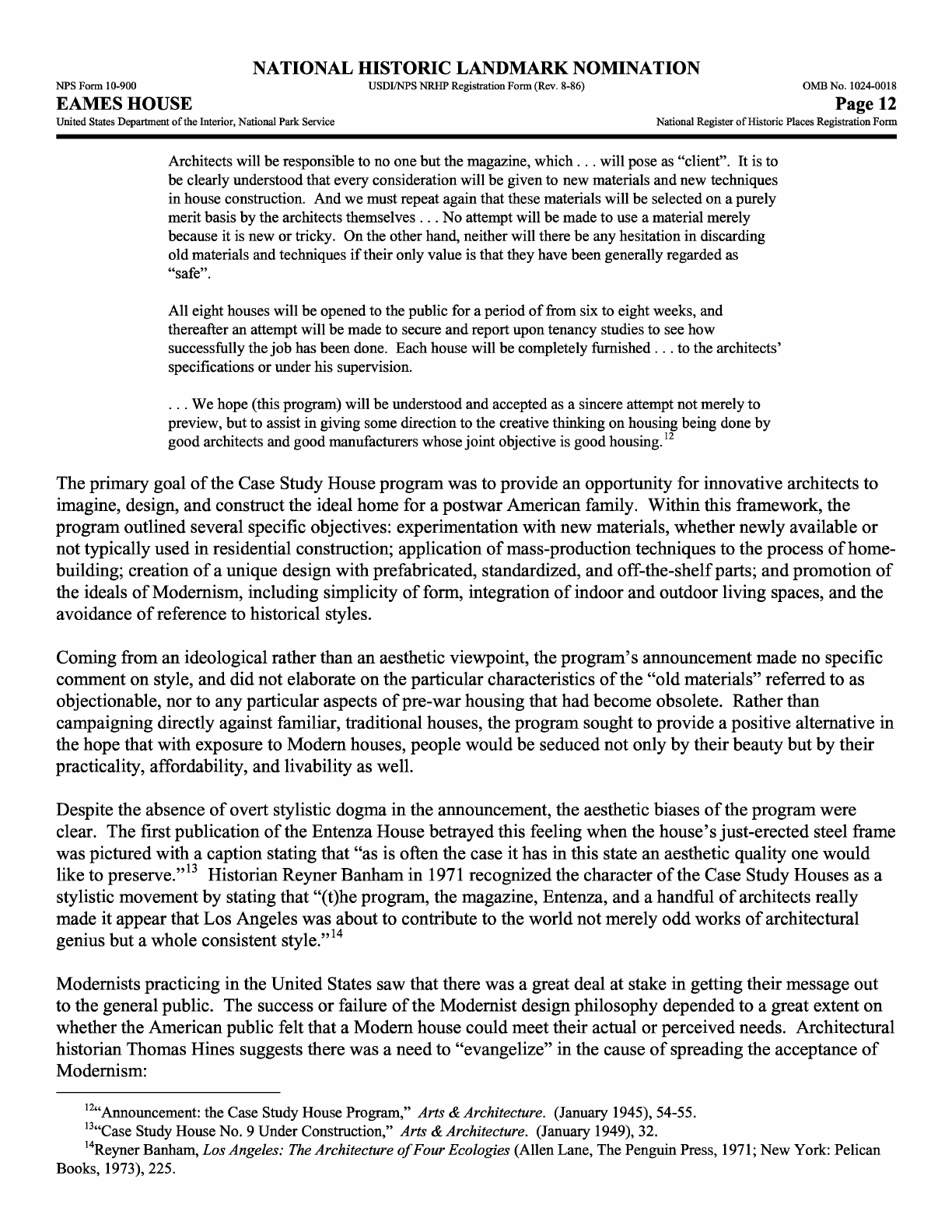
NATIONAL
HISTORIC
LANDMARK
NOMINATION
NFS
Form
10-900
USDI/NPS
NRHP
Registration
Form
(Rev.
8-86)
OMB
No.
1024-0018
EAMES
HOUSE
Page
12
United
States
Department
of
the
Interior,
National
Park
Service
National
Register
of
Historic
Places
Registration
Form
Architects
will
be
responsible
to no one
but
the magazine,
which...
will
pose
as
"client".
It
is
to
be
clearly
understood that
every
consideration
will
be
given
to
new
materials
and
new
techniques
in house
construction.
And
we
must
repeat
again
that
these
materials
will
be
selected
on a
purely
merit
basis
by
the
architects
themselves
...
No
attempt
will
be
made
to
use
a
material
merely
because
it
is
new or
tricky.
On the
other
hand,
neither
will
there be
any
hesitation
in
discarding
old
materials
and techniques
if
their
only
value
is
that
they
have
been
generally
regarded
as
"safe".
All
eight
houses
will
be
opened
to
the
public
for
a
period
of
from
six
to
eight
weeks,
and
thereafter
an
attempt
will
be
made
to secure
and report
upon
tenancy
studies
to
see
how
successfully
the
job
has
been
done.
Each
house
will
be
completely
furnished...
to
the
architects'
specifications
or
under
his
supervision.
...
We
hope
(this
program)
will
be
understood
and
accepted
as
a
sincere
attempt
not
merely
to
preview,
but
to
assist
in
giving
some
direction
to
the
creative
thinking
on
housing
being
done
by
good
architects
and
good
manufacturers
whose
joint
objective
is
good
housing.
12
The
primary
goal
of
the
Case
Study
House
program
was
to
provide
an
opportunity
for
innovative
architects
to
imagine,
design,
and
construct
the
ideal
home
for
a
postwar
American
family.
Within
this
framework,
the
program
outlined
several
specific objectives:
experimentation
with
new
materials,
whether
newly
available
or
not
typically
used
in
residential
construction;
application
of
mass-production
techniques
to
the
process
of
home-
building;
creation
of
a
unique
design
with prefabricated,
standardized,
and
off-the-shelf
parts;
and
promotion
of
the
ideals
of
Modernism,
including
simplicity
of
form,
integration
of
indoor
and
outdoor
living
spaces,
and
the
avoidance
of
reference
to
historical
styles.
Coming
from
an
ideological
rather
than
an aesthetic
viewpoint,
the
program's
announcement
made
no
specific
comment
on
style,
and did
not
elaborate
on
the
particular
characteristics
of
the
"old
materials"
referred
to
as
objectionable,
nor
to
any
particular
aspects
of
pre-war
housing
that
had
become
obsolete.
Rather than
campaigning
directly
against
familiar,
traditional
houses,
the
program
sought
to
provide
a
positive
alternative
in
the
hope
that
with
exposure
to
Modern
houses,
people
would
be
seduced
not
only
by
their beauty
but
by
their
practicality,
affordability,
and
livability
as
well.
Despite
the
absence
of
overt
stylistic
dogma
in
the
announcement,
the
aesthetic
biases
of
the
program
were
clear.
The
first
publication
of
the
Entenza
House
betrayed
this
feeling
when
the
house's
just-erected
steel
frame
was
pictured
with
a
caption
stating
that
"as
is
often
the
case
it
has
in
this
state
an aesthetic
quality
one
would
1
"^
like
to
preserve."
Historian
Reyner
Banham
in
1971
recognized
the
character
of
the
Case
Study
Houses
as
a
stylistic
movement
by
stating
that
"(t)he
program,
the
magazine, Entenza,
and
a
handful
of
architects
really
made
it
appear
that
Los
Angeles
was
about
to
contribute
to
the
world
not
merely
odd
works
of
architectural
genius
but
a
whole
consistent
style."
14
Modernists
practicing
in
the
United
States
saw
that
there was
a
great
deal
at
stake
in
getting
their
message
out
to
the
general
public.
The
success
or
failure
of
the
Modernist
design
philosophy depended
to
a
great
extent
on
whether
the
American
public
felt
that
a
Modern
house
could
meet
their
actual
or
perceived
needs.
Architectural
historian
Thomas
Hines suggests
there was
a
need
to
"evangelize"
in
the
cause
of
spreading
the
acceptance
of
Modernism:
12
"Announcement:
the
Case
Study
House
Program,"
Arts
&
Architecture.
(January
1945),
54-55.
13
"Case
Study
House
No.
9
Under
Construction,"
Arts
&
Architecture. (January
1949),
32.
14
Reyner
Banham,
Los
Angeles:
The
Architecture
of
Four
Ecologies
(Alien
Lane,
The
Penguin
Press,
1971;
New
York:
Pelican
Books,
1973),
225.
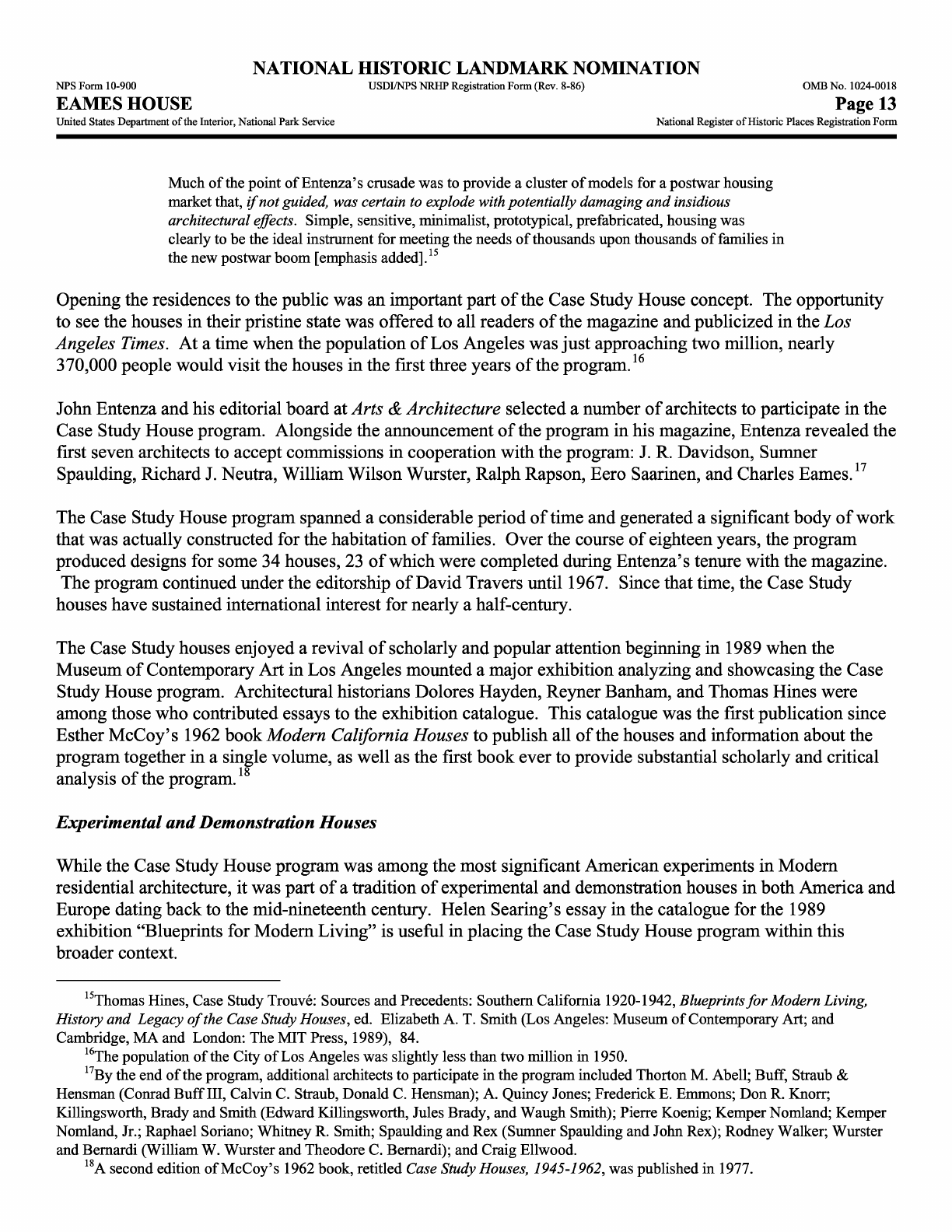
NATIONAL
HISTORIC
LANDMARK
NOMINATION
NFS
Form
10-900
USDI/NPS
MRHP
Registration
Form
(Rev.
8-86)
OMB
No.
1024-0018
EAMES
HOUSE
Page
13
United
States
Department
of
the
Interior,
National
Park
Service
National
Register
of
Historic
Places
Registration
Form
Much
of
the
point
of
Entenza's
crusade
was
to
provide
a
cluster
of
models
for
a
postwar
housing
market
that,
if
not
guided,
-was
certain
to
explode
-with
potentially
damaging
and
insidious
architectural
effects. Simple,
sensitive,
minimalist,
prototypical,
prefabricated,
housing
was
clearly
to
be
the
ideal
instrument
for
meeting
the
needs
of
thousands
upon
thousands
of
families
in
the
new
postwar boom
[emphasis
added].
15
Opening
the
residences
to
the
public
was
an
important
part
of
the
Case
Study
House
concept.
The
opportunity
to
see
the
houses
in
their
pristine
state
was
offered
to
all
readers
of
the
magazine
and
publicized
in
the
Los
Angeles
Times.
At
a
time
when
the
population
of
Los
Angeles
was
just
approaching
two million,
nearly
370,000
people
would
visit
the
houses
in
the
first
three
years
of
the
program.
16
John
Entenza and
his
editorial
board
at
Arts
&
Architecture
selected
a
number
of
architects
to
participate
in
the
Case
Study
House program.
Alongside
the
announcement
of
the
program
in
his
magazine,
Entenza
revealed
the
first
seven
architects
to
accept
commissions
in
cooperation
with
the
program:
J.
R.
Davidson,
Sumner
Spaulding,
Richard
J.
Neutra,
William
Wilson
Wurster,
Ralph
Rapson,
Eero
Saarinen,
and
Charles
Eames.
17
The
Case
Study
House
program
spanned
a
considerable
period
of
time
and
generated
a
significant
body
of
work
that
was
actually
constructed
for
the
habitation
of
families.
Over
the
course
of
eighteen
years,
the
program
produced
designs
for
some
34
houses,
23
of
which
were
completed
during
Entenza's
tenure
with
the
magazine.
The
program
continued
under
the
editorship
of
David
Travers
until
1967.
Since
that
time,
the
Case
Study
houses
have
sustained
international
interest
for
nearly
a
half-century.
The
Case
Study
houses
enjoyed
a
revival
of
scholarly
and
popular
attention
beginning
in
1989
when
the
Museum
of
Contemporary
Art
in
Los
Angeles
mounted
a
major
exhibition
analyzing
and
showcasing
the
Case
Study
House
program.
Architectural
historians
Dolores
Hayden,
Reyner
Banham,
and
Thomas
Hines
were
among
those
who
contributed
essays
to
the
exhibition
catalogue.
This
catalogue
was
the
first
publication
since
Esther
McCoy's
1962
book
Modern
California
Houses
to
publish
all
of
the
houses
and
information
about
the
program
together
in
a
single
volume,
as
well
as
the
first
book
ever
to
provide
substantial
scholarly
and
critical
analysis
of
the
program.
18
Experimental
and
Demonstration
Houses
While
the
Case
Study
House
program
was
among
the
most significant
American
experiments
in
Modern
residential
architecture,
it
was
part
of
a
tradition
of
experimental
and
demonstration
houses
in
both
America
and
Europe
dating
back
to
the
mid-nineteenth
century.
Helen
Searing's
essay
in
the
catalogue for
the
1989
exhibition
"Blueprints
for
Modern
Living"
is
useful
in
placing
the
Case
Study
House
program
within
this
broader
context.
15
Thomas
Hines,
Case
Study
Trouve:
Sources
and
Precedents:
Southern
California
1920-1942,
Blueprints
for
Modern
Living,
History
and
Legacy
of
the
Case
Study
Houses,
ed.
Elizabeth
A.
T.
Smith (Los
Angeles:
Museum
of
Contemporary
Art;
and
Cambridge,
MA
and
London:
The
MIT
Press,
1989),
84.
16
The
population
of
the
City
of
Los
Angeles
was
slightly
less
than
two
million
in
1950.
17
By the
end
of
the
program, additional
architects
to
participate
in
the
program
included
Thorton
M.
Abell;
Buff,
Straub
&
Hensman
(Conrad
Buff
III,
Calvin
C.
Straub,
Donald
C.
Hensman);
A.
Quincy
Jones;
Frederick
E.
Emmons;
Don
R.
Knorr;
Killingsworth,
Brady
and
Smith
(Edward
Killingsworth,
Jules
Brady,
and
Waugh
Smith);
Pierre
Koenig;
Kemper
Nomland;
Kemper
Nomland,
Jr.;
Raphael
Soriano;
Whitney
R.
Smith;
Spaulding
and
Rex
(Sumner
Spaulding
and
John
Rex);
Rodney
Walker;
Wurster
and
Bernardi (William
W.
Wurster
and
Theodore
C.
Bernardi);
and
Craig
Ellwood.
18
A
second edition
of
McCoy's
1962
book,
retitled
Case
Study
Houses,
1945-1962,
was
published
in
1977.
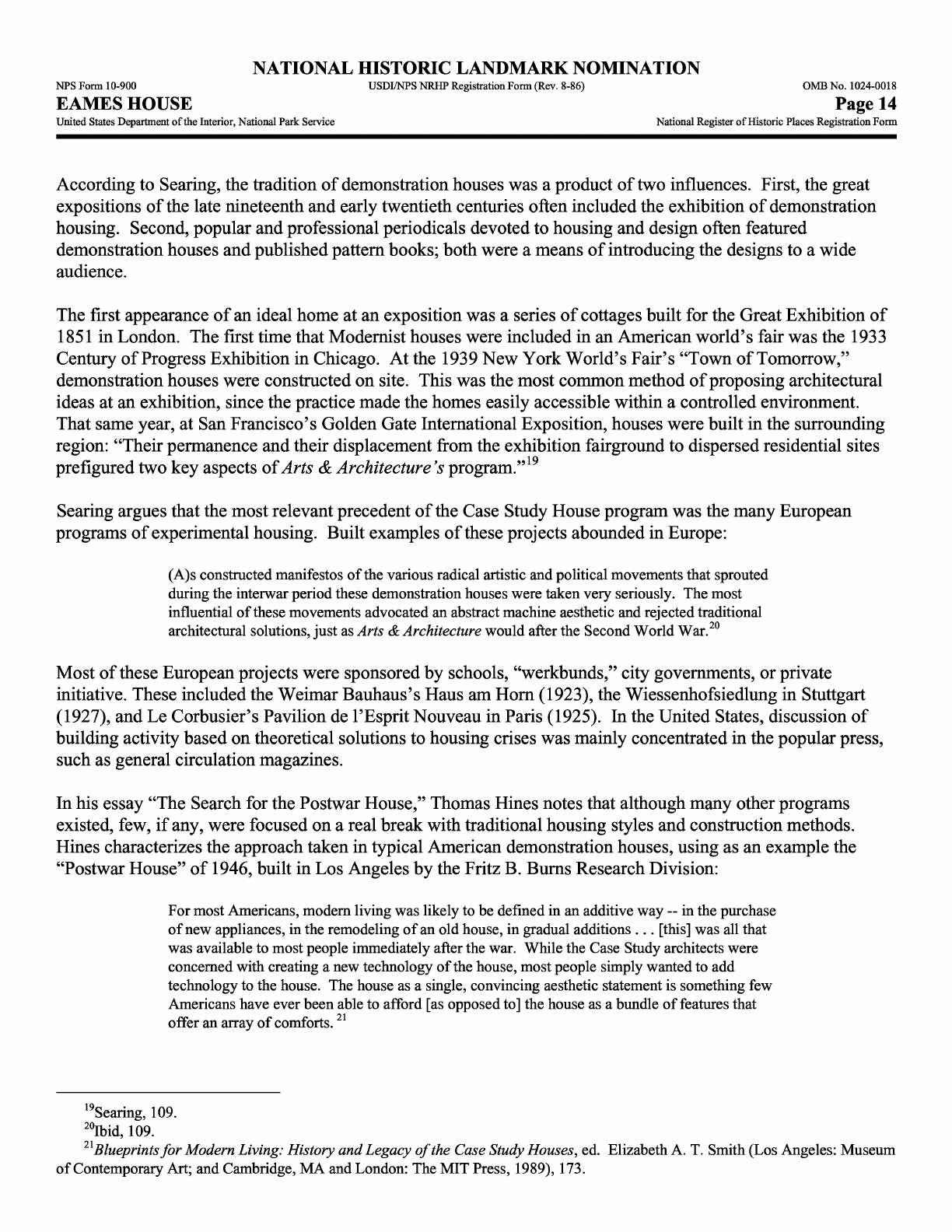
NATIONAL
HISTORIC
LANDMARK
NOMINATION
NFS
Form
10-900
USDI/NPS
MRHP
Registration
Form
(Rev.
8-86)
OMB
No.
1024-0018
EAMES
HOUSE
Page
14
United
States
Department
of
the
Interior,
National
Park
Service
National
Register
of
Historic
Places
Registration
Form
According
to
Searing,
the
tradition
of
demonstration
houses
was
a
product
of
two influences.
First,
the
great
expositions
of
the
late
nineteenth
and
early
twentieth
centuries
often
included
the
exhibition
of
demonstration
housing.
Second,
popular
and
professional
periodicals devoted
to
housing
and
design
often featured
demonstration
houses
and
published
pattern
books;
both
were
a
means
of
introducing
the
designs
to
a
wide
audience.
The
first appearance
of
an
ideal
home
at
an
exposition
was
a
series
of
cottages
built
for
the
Great
Exhibition
of
1851
in
London.
The
first time
that
Modernist
houses
were
included
in
an
American
world's
fair was
the
1933
Century
of
Progress
Exhibition
in
Chicago.
At
the
1939
New
York
World's
Fair's
"Town
of
Tomorrow,"
demonstration
houses
were
constructed
on
site.
This
was
the
most
common
method
of
proposing
architectural
ideas
at
an
exhibition,
since
the
practice
made
the
homes
easily
accessible
within
a
controlled
environment.
That
same
year,
at
San
Francisco's
Golden
Gate
International
Exposition, houses
were
built
in
the
surrounding
region:
"Their
permanence
and
their
displacement
from
the
exhibition fairground
to
dispersed residential
sites
prefigured
two
key
aspects
of
Arts
&
Architecture's
program."
19
Searing
argues
that
the
most
relevant
precedent
of
the
Case
Study
House
program
was
the
many
European
programs
of
experimental
housing.
Built
examples
of
these
projects
abounded
in
Europe:
(A)s
constructed
manifestos
of
the
various
radical
artistic and
political
movements
that
sprouted
during
the
interwar
period
these
demonstration
houses
were
taken
very
seriously.
The
most
influential
of
these
movements
advocated
an
abstract
machine
aesthetic
and
rejected
traditional
architectural
solutions,
just
as
Arts
&
Architecture
would
after
the
Second
World
War.
20
Most
of
these
European
projects
were
sponsored
by
schools,
"werkbunds,"
city
governments,
or
private
initiative.
These
included
the
Weimar
Bauhaus's
Haus
am
Horn
(1923),
the
Wiessenhofsiedlung
in Stuttgart
(1927),
and
Le
Corbusier's
Pavilion
de
1'Esprit
Nouveau
in Paris
(1925).
In
the
United
States,
discussion
of
building
activity
based
on
theoretical
solutions
to
housing
crises
was
mainly concentrated
in
the
popular
press,
such
as
general
circulation
magazines.
In
his
essay
"The
Search
for
the
Postwar
House,"
Thomas
Hines
notes
that
although
many
other programs
existed,
few,
if
any,
were
focused
on
a
real
break
with
traditional housing
styles
and construction
methods.
Hines
characterizes
the
approach
taken
in
typical
American
demonstration
houses,
using
as
an
example
the
"Postwar
House"
of
1946,
built
in
Los
Angeles
by
the
Fritz
B.
Burns
Research
Division:
For
most
Americans,
modern
living was likely
to
be
defined
in
an
additive
way
~
in
the
purchase
of
new
appliances,
in
the
remodeling
of
an
old
house,
in
gradual
additions
...
[this]
was
all
that
was
available
to
most
people
immediately
after
the
war.
While
the
Case
Study
architects were
concerned with
creating
a
new
technology
of
the
house,
most
people
simply
wanted
to
add
technology
to
the
house.
The
house
as
a
single,
convincing
aesthetic
statement
is
something
few
Americans
have
ever
been
able to
afford
[as
opposed
to]
the
house
as
a
bundle
of
features
that
offer
an
array
of
comforts.
21
19
Searing,
109.
20
Ibid,
109.
21
[
Blueprints
for
Modern
Living:
History
and
Legacy
of
the
Case
Study
Houses,
ed.
Elizabeth
A.
T.
Smith
(Los
Angeles:
Museum
of
Contemporary
Art;
and Cambridge,
MA
and
London:
The
MIT
Press,
1989),
173.

NATIONAL
HISTORIC
LANDMARK
NOMINATION
NFS
Form
10-900
USDI/NPS
MRHP
Registration
Form
(Rev.
8-86)
OMB
No.
1024-0018
EAMES
HOUSE
Page
15
United
States
Department
of
the
Interior,
National
Park
Service
National
Register
of
Historic
Places
Registration
Form
According
to
the
authors
of
the
catalogue
for
the
Blueprints
for
Modern
Living
exhibition,
the
Case
Study
House
program
was
unique
in
its
ability
to
bring
Modern
design,
manufacturing,
and
habitation
to
an
American
audience.
No
other American
architectural
competition,
program, or
exhibition
was
comparable
to
those
seen
in
Europe
in
the
period
between
the
two
world
wars.
The
Pacific
Palisades
Site
On
February
15,
1945,
John
Entenza
purchased
five
acres
of
land
along
the
California
coast
in
the
northern
Los
Angeles County
community
of
Pacific
Palisades.
This
new
tract
would
become
the
land
upon
which
Entenza
would
develop
the
nucleus
of
the
Case
Study
House
program.
The
area
now
occupied
by
the
community
of
Pacific
Palisades
was
first
inhabited
by
Native
Americans,
who
settled
in
the
seaside
canyons.
In
1839,
the
governor
of
California
at
Monterey
granted
the
6,656-acre
tract
of
low
hills,
broad
mesas,
and
wooded
canyons
to
Francisco Marquez
and
Ysidro
Reyes,
who
established
Rancho
Boca
de
Santa
Monica.
Pacific
Palisades
was
founded
on this
land
in
1922
by
Reverend
Charles
H.
Scott
as
a
site
for
the
local
Summer
Assemblies
of
the
Chautauqua
Movement.
The
Chautauqua
Movement
grew
out
of
the
idea
of
a
summer
school
for
Sunday
school
teachers
of
the
Methodist
Church
in
the
1870s.
It
was
soon
discovered
that
there
was
a
wider
audience
for
broader
offerings
in
many
areas
of
education
and
culture.
"The
early
Chautauqua
Institution
provided
a
broad
range
of
educational
and
cultural
offerings,
from
musical
performances
to
lectures
and
instruction
on
every
conceivable
topic."
22
The
Pacific
Palisades
assembly
took
place over
a
six
week
period,
drawing
people from
throughout
the
Southwest.
23
The
community's
historical
roots
in
the
Chautauqua
Summer
Assemblies
is
still
evident.
Marquez
Avenue,
named
after
the
family
who
co-owned
the
original
Spanish
land
grant,
was
renamed
Chautauqua
Boulevard
in
1928.
24
Following
the
regional
trend
of
the
1920s,
residents
of
Pacific
Palisades
increasingly
turned
their
attention
to
real
estate
promotion
and
business
development.
The
Olmstead
Brothers'
firm,
who
designed
a
number
of
subdivisions and
town
plans
throughout
Southern
California
in
the
teens
and
1920s,
was
commissioned
to
develop
a
city
plan
for
Pacific
Palisades.
The
first
business
block
of
the
emerging commercial
area
along
Beverly (later
an
extension
of
Sunset)
Boulevard
was
completed
in
1924.
Simple
wood-frame
houses
designed
in
the
Southern
California
vernacular,
with
rectangular
plans,
small
porches,
and
wood
siding,
were
also
widely
constructed
during
this
period.
Los
Angeles
County
tax assessor
records,
available
beginning
in
1902,
show
that
the
land
comprising
the
Entenza
tract
was
subdivided
along
the
northern
bend
of
Chautauqua
Boulevard
(then
Terrace
Drive)
into
small
lots
as
a
part
of
the
larger
Santa
Monica
Heights
subdivision.
By
1931,
after
having
had
numerous other
owners,
Tract
#9473,
Block
6,
Lots
6
and
7,
had
been
purchased
by
humorist
Will Rogers.
This
is
the
extent
of
the
property
that
was
sold
to
John
Entenza
in
1945.
Entenza
divided
the
property
into
two
large
lots
(#1
and
#2)
and
four
smaller
lots
(#3
through
#6),
establishing
Tract
#13251.
The
Los
Angeles
Bureau
of
Engineering
22
Martha
Vale,
Colorado
Chautauqua
National
Historic
Landmark
Nomination,
(National
Historic
Landmark
files,
National
Park
Service,
Washington,
DC), 2005.
23
Betty
Lou
Young,
Pacific
Palisades,
Where
the
Mountains
Meet
the
Sea,
ed.
Betty
Lou
Young
(Pacific
Palisades,
CA:
Pacific
Palisades Historical
Society Press,
1983),
22.
24
Marquez
Road
ran
throughout
the
Palisades.
During
the
1920s,
sections
of
it
were
divided
off,
renamed,
and
improved.
This
was
the
same
period
when
the
town
of
Pacific
Palisades
was
founded
and
most
of
the
area
was
subdivided.
These
activities
occasioned
the
widespread
reorganization
of
the
street
pattern
and
the
grading
of
new
streets.

NATIONAL
HISTORIC
LANDMARK
NOMINATION
NFS
Form
10-900
USDI/NPS
MRHP
Registration
Form
(Rev.
8-86)
OMB
No.
1024-0018
EAMES
HOUSE
Page
16
United
States
Department
of
the
Interior,
National
Park
Service
National
Register
of
Historic
Places
Registration
Form
approved
the
new
tract
on
October
26,
1945.
Between
January
20
and
23,
1947,
John
Entenza
sold
off
most
of
the
lots
in
the
tract
to
individual
owners,
retaining
ownership
of
the
two largest
lots,
#1
and
#2,
which
would
become
the
sites
of
the
Eames
and
Entenza
houses,
respectively.
25
The
location
of
the
Eames
House
on
a
hillside
lot
along
Los
Angeles'
urban
periphery
is
typical
of
the
Case
Study
houses.
The
majority
of
the
Case
Study
houses
were
situated
in
foothills
and
canyons
on
the
edges
of
the
city.
Communities
such
as
Pasadena,
La
Canada,
and
Altadena
to
the
east,
and
West
Los
Angeles, Brentwood,
and
Pacific
Palisades
to
the
west,
are
all
home
to
Case
Study
houses.
The
foothills
surrounding
Los
Angeles offer
a
sense
of
seclusion
and
remoteness,
despite
being
immediately
adjacent
to
some
of
the
city's
most
populated
centers.
Varied
topography,
lush
greenery,
mild
microclimates,
and eclectic
architecture
are
a
dramatic
contrast
to
the sometimes
monotonous
grid
of
the
basin.
Historian
Reyner
Banham, in
his
classic
work
on
the
cityscape
of
Los
Angeles,
Los
Angeles:
the
Architecture
of
Four
Ecologies,
described
the
"ecology"
of
the
foothills:
That
is
what
the
foothill
ecology
is
really
all
about:
narrow,
tortuous
residential
roads
serving
precipitous
house-plots
that
often
back
up
directly
on
unimproved
wilderness
even
now
[1972];
an
air
of
deeply
buried
privacy
even
in
relatively
broad
valley-bottoms
in
Stone
Canyon
or
Mandeville
Canyon
...
[T]his
is
a
landscape
that
seems
to
cry out
for
affluent
suburban
residences,
and
to
flourish
when
so
employed.
26
By
the
end
of
World
War
II,
the
foothills
were
already established
as
the
preferred
geography
for
avant-garde
and
Modernist
architecture
in
Los
Angeles.
Esther
McCoy
suggests
the
popularity
of
the
hills
dates
back
to
the
building boom
of
the
1920s,
when
lots
deemed
"unbuildable"
by
most
developers
could
be
purchased
for
a
fraction
of
the
average
per-acre
price.
Modernism
in
Los Angeles
The
earliest
houses
by
many
of
the
twentieth
century's
most pioneering
architects,
some
of
whom
would
participate
in
the
Case
Study
House
program,
were
constructed
in
the
hills
above
Los
Angeles.
Frank
Lloyd
Wright,
Richard
J.
Neutra,
Rudolph
M.
Schindler,
Gregory
Ain,
J.
R.
Davidson,
Raphael
Soriano,
Craig
Ellwood,
Pierre
Koenig,
and Ray
Kappe
all
designed
homes
in
the
city's
hills
and
canyons.
Indeed,
the
association
of
Modernist
architecture
with
certain
Los
Angeles
foothill
and
canyon
neighborhoods
remains
firm
today.
Within
this
physical
and
social context,
the
location
of
the
Eames
House
within
Entenza's
original
Case
Study
House
tract
was
consistent
with
the
tradition
of
such
houses
in
the
Los
Angeles
area,
and
indeed
became
an
important
part
of
that
tradition.
The
west
side
of
Los
Angeles
generally,
and
Pacific
Palisades
in
particular,
was
the
home
of
several
noted
artists
and
intellectuals
who
had
fled
the
political
climate
of
Germany
under
National
Socialist
rule.
Proximity
to
the
University
of
California
at
Los
Angeles
was
a
likely
factor
in
the
west
side's
popularity
among
this
group,
as
was
the
availability
of
land
and
the
mild
climate.
Composer
Igor
Stravinsky,
novelist
Thomas
Mann,
25
New
lot
owners
included
Clarence
J.
and
Mildred
A.
Harasta
(Lot
3),
M.
B.
Scott
(Lot
4),
Stuart
G.
and
Lucia
F.
Bailey (Lot
5),
and
Roy
and Bonnie
Huggins
(Lot
6).
Mr.
and
Mrs.
Harasta's
names
appear
on the
building
permit
for
Rodney
Walker's
Case
Study
House
#18.
Dr.
and
Mrs.
Bailey
would
soon
become
participants
in the Case
Study
House
program.
Mr.
and
Mrs.
Huggins
did
not
become
involved with
the
program,
and Lot
6
was
not
developed
within
the
program.
26
Reyner
Banham,
Los
Angeles:
The
Architecture
of
Four
Ecologies
(Alien
Lane,
The
Penguin
Press,
1971;
New
York:
Pelican
Books,
1973),
99-100.
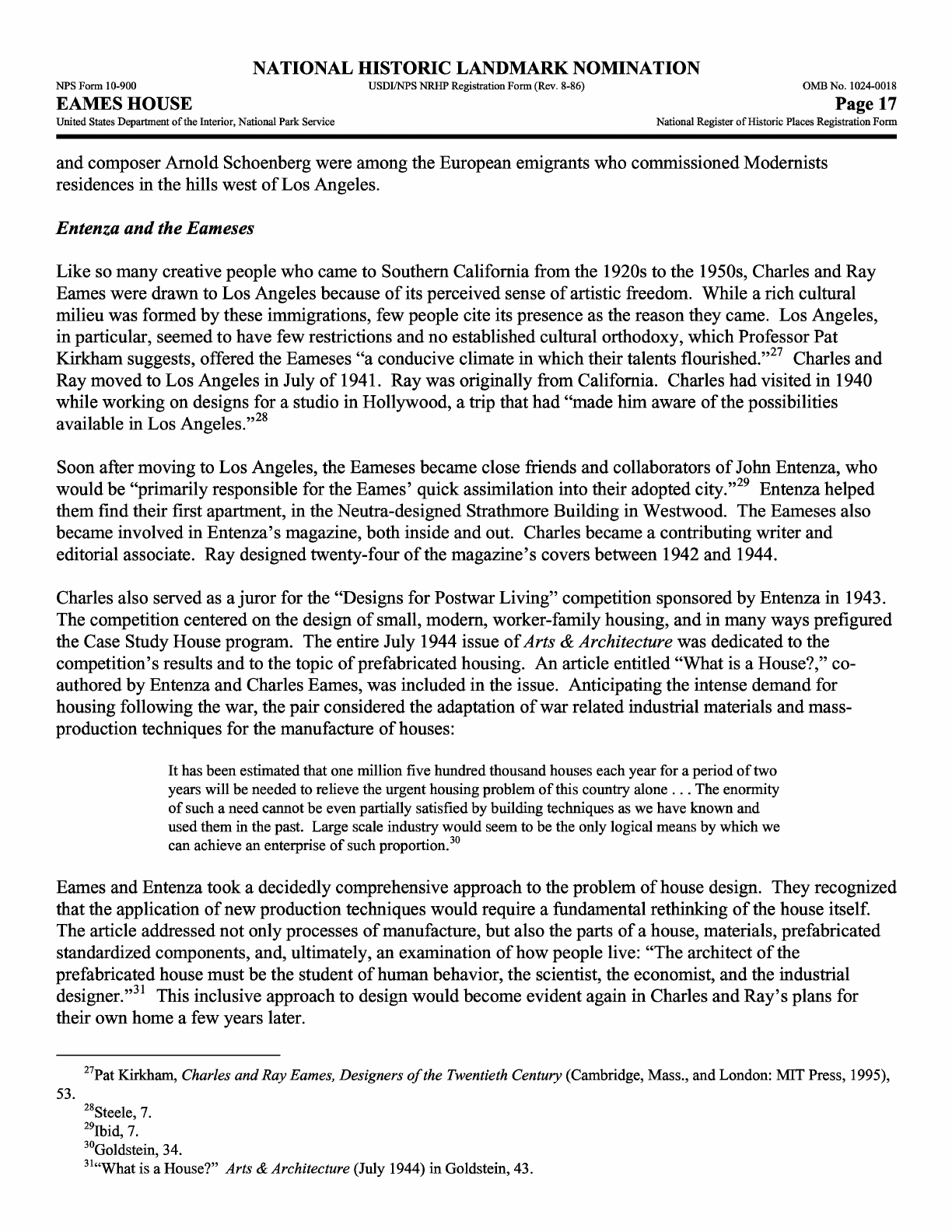
NATIONAL
HISTORIC
LANDMARK
NOMINATION
NFS
Form
10-900
USDI/NPS
NRHP
Registration
Form
(Rev.
8-86)
OMB
No.
1024-0018
EAMES
HOUSE
Page
17
United
States
Department
of
the
Interior,
National
Park
Service
National
Register
of
Historic
Places
Registration
Form
and
composer
Arnold
Schoenberg were
among
the
European
emigrants who
commissioned
Modernists
residences
in
the
hills
west
of
Los
Angeles.
Entenza
and
the
Eameses
Like
so
many
creative
people
who
came
to
Southern
California
from
the
1920s
to
the
1950s,
Charles
and
Ray
Eames
were
drawn
to
Los
Angeles
because
of
its
perceived
sense
of
artistic
freedom.
While
a
rich
cultural
milieu
was
formed
by
these
immigrations,
few
people
cite
its
presence
as
the
reason
they
came.
Los
Angeles,
in
particular,
seemed
to
have
few
restrictions
and
no
established
cultural orthodoxy,
which
Professor
Pat
Kirkham
suggests,
offered
the
Eameses
"a
conducive
climate
in
which their
talents
flourished."
27
Charles
and
Ray
moved
to
Los
Angeles
in
July
of
1941.
Ray
was
originally
from California.
Charles
had
visited
in
1940
while
working
on
designs
for
a
studio
in
Hollywood,
a
trip
that
had
"made
him
aware
of
the
possibilities
available
in
Los
Angeles."
28
Soon
after
moving
to
Los
Angeles,
the
Eameses
became
close
friends
and
collaborators
of
John Entenza, who
would
be
"primarily
responsible
for
the
Eames'
quick
assimilation
into
their
adopted city."
29
Entenza
helped
them
find
their
first
apartment,
in
the
Neutra-designed
Strathmore
Building
in
Westwood.
The
Eameses
also
became
involved
in
Entenza's
magazine,
both
inside
and
out.
Charles
became
a
contributing
writer
and
editorial
associate.
Ray designed
twenty-four
of
the
magazine's
covers
between
1942
and
1944.
Charles
also
served
as
a
juror
for
the
"Designs
for
Postwar
Living"
competition sponsored
by
Entenza
in
1943.
The
competition
centered
on
the
design
of
small,
modern,
worker-family
housing,
and
in
many
ways
prefigured
the
Case
Study
House
program.
The entire
July
1944
issue
of
Arts
&
Architecture
was
dedicated
to
the
competition's
results
and
to
the
topic
of
prefabricated
housing.
An
article
entitled
"What
is
a
House?,"
co-
authored
by
Entenza and
Charles Eames,
was
included
in
the
issue.
Anticipating
the
intense
demand
for
housing
following
the
war,
the
pair
considered
the
adaptation
of
war
related
industrial
materials
and
mass-
production
techniques
for
the
manufacture
of
houses:
It
has
been
estimated that
one
million
five
hundred
thousand
houses each
year
for
a
period
of
two
years
will
be
needed
to
relieve
the
urgent
housing
problem
of
this
country
alone
...
The
enormity
of
such
a
need
cannot be even
partially
satisfied
by
building
techniques
as
we
have
known
and
used
them
in the
past.
Large
scale
industry
would
seem
to
be
the
only
logical
means
by
which
we
can
achieve
an enterprise
of
such
proportion.
30
Eames
and
Entenza
took
a
decidedly
comprehensive
approach
to
the
problem
of
house
design.
They
recognized
that
the
application
of
new
production
techniques
would
require
a
fundamental
rethinking
of
the
house
itself.
The
article
addressed
not
only
processes
of
manufacture,
but
also
the
parts
of
a
house,
materials,
prefabricated
standardized
components,
and,
ultimately,
an
examination
of
how
people
live:
"The architect
of
the
prefabricated
house
must
be
the
student
of
human
behavior,
the
scientist,
the
economist,
and
the
industrial
designer."
31
This
inclusive
approach
to
design
would
become
evident
again
in
Charles
and
Ray's
plans
for
their
own
home
a
few
years
later.
27
Pat
Kirkham,
Charles
and
Ray
Eames,
Designers
of
the
Twentieth
Century
(Cambridge,
Mass.,
and
London:
MIT
Press,
1995),
53.
28
Steele,
7.
29
Ibid,
7.
30
Goldstein,
34.
31
"What
is
a
House?"
Arts
&
Architecture
(July
1944)
in
Goldstein,
43.

NATIONAL
HISTORIC
LANDMARK
NOMINATION
NFS
Form
10-900
USDI/NPS
NRHP
Registration
Form
(Rev.
8-86)
OMB
No.
1024-0018
EAMES
HOUSE
Page
18
United
States
Department
of
the
Interior,
National
Park
Service
National
Register
of
Historic
Places
Registration
Form
Case
Studies
#8
and
#9
Charles
Eames
and
Eero
Saarinen
were
among
the
first
eight
architects
invited
to
participate
in
Entenza's
Case
Study
House program.
Charles's
association
with
Saarinen
dated
back
to
his
attendance
at
the
Cranbrook
Academy
of
Art
in
Michigan.
Charles
had
been
a
protege
of
the
academy's
director,
Eliel
Saarinen,
who
had
offered
him
a
scholarship
to
the school in
1938.
The
following
year,
Saarinen
made
him
an
instructor
in
the
Intermediate
School
of
Design,
and
in
1940
the
head
of
the
Department
of
Industrial
Design.
During
this
period,
Charles
developed
a
friendship
with
Eliel
Saarinen's
son,
Eero.
The
two
shared
common
ideas
about
modernist
solutions to
architectural
and
design
issues:
(I)t
was
largely
through
Eero
that
Charles
became
a
full-fledged
modernist,
determined
to
research
every
aspect
of
a
project
and
to
use
the
techniques
of
mass
production
to
improve
the
human
environment
for
the
population
at
large.
32
Charles
and
Eero
collaborated
on
three
projects
while
at
Cranbrook.
The
most
significant
and
best
known
of
these
was
the
1940
competition "Organic Design
in
Home
Furnishings,"
sponsored
by
the
Museum
of
Modern
Art
in
New
York.
The
pair
won
all
categories
of
this
competition
with
their
upholstered,
molded
plywood
chairs,
molded
plywood
tables,
and
horizontal
storage
units
elevated
on
benches.
The
techniques
used
in
manufacturing
these
designs
would
inform
Charles'
furniture designs
for
the
next
decade.
33
The
collaboration
between
Charles
and
Eero
culminated
in
the design
of
two
Case
Study
Houses,
#8
for
the
Eameses
and
#9
for
John
Entenza,
which
were
planned
relative
to
one
another
on
adjacent
sites
in Pacific
Palisades.
The
site
plans
for
the
two
houses
were
first
presented
in
a
single
drawing
by
Charles
and
Eero.
This
sketch
depicts
the
original
design
for
the
Eames House,
known
as
the
"the
Bridge
House."
In
this design,
the
house
is
a
single-story
steel
frame
and
glass
rectangle,
with
the
studio
component
placed
in
at
an
angle
forming
a
disconnected
acute
L-shape
in
plan.
The
living
component
is
sited
perpendicular
to
the
steep
hillside
on
the
west
edge
of
the
property,
and
partially
cantilevered
out
over
the
downward
slope
of
the meadow.
The
walls
along
the
south
elevation
are
paneled
with
glass,
taking
full
advantage
of
the
ocean
view
and
retaining
the
privacy
of
the
adjacent
Entenza
House.
Charles's
1947
visit
to
a
Mies
van
der
Rohe
exhibition
at
the
New
York
Museum
of
Modern
Art
is
generally
considered
the
motivation
behind
the
complete
redesign
of
the
house.
A
conceptual
sketch
for
a
linear,
elevated
steel
and
glass
house
on
display
at
the
exhibition
was
remarkably
similar
to
the
design
Eames
and
Saarinen
had
developed
with
engineer
Edgardo
Contini.
Many
critics
have
argued
that
Eames
changed
the
design
in
order
to
avoid appearing
derivative
of
Mies.
Yet,
in
his
monograph
on
the
Eames House,
architect
and
author
James
Steele
expresses
reservations
that
this
sufficiently
explains
the
major
changes made to the
design.
Perhaps
more
important
than
the
catalyst
was
the
house's
realignment
that,
according
to
Ray
Eames,
reflected
their
experience
and
use
of
the
site
during
the
two
years
elapsing
between
publication
of
the
original
design
and
the
delivery
of
materials
to
the
site.
Ray
reminisced
that
during
the
period,
"they
had
fallen
in
love
with
the
meadow."
34
Upon
his
return
from
New
York
in
1947,
Charles
Eames
completely
redesigned
the house,
even
though
the
building
parts
had
already
been
fabricated
and
delivered
to
the
site.
The
Eameses and
Arts
&
Architecture
32
Kirkham,
49.
33
Steele,
7.
34
Eames
Demetrios,
An
Eames
Primer
(New
York:
Universe
Publishing, 2001),
136.

NATIONAL
HISTORIC
LANDMARK
NOMINATION
NFS
Form
10-900
USDI/NPS
NRHP
Registration
Form
(Rev.
8-86)
OMB
No.
1024-0018
EAMES
HOUSE
Page
19
United
States
Department
of
the
Interior,
National
Park
Service
National
Register
of
Historic
Places
Registration
Form
magazine
contended
that
the
house
was
reconsidered
in
order
to
better
utilize
the
already
purchased
materials,
thereby
emphasizing
the
concept
of
a
kit-of-parts
from
which
a
variety
of
possible
designs
could
be
constructed.
The
Entenza
House
was
built
as
originally designed
and
despite
the
rethinking
of
the
Eames
House,
the
two
adjacent
Case
Study
houses
still
had
much
in
common.
Architectural
Forum described them
as
"technological
twins
but
architectural
opposites."
35
The
two
houses
share
the
same
structural
system
of
a
steel frame
and open
web
joists,
though
they
were
enclosed
by
different
materials.
Distinguishing
the
Eames
House
from
its
neighbor,
the
structural
elements
of
Case
Study
House
#8
are
exposed
on
the
interior
and
the exterior,
making
apparent
the
exceptionally
thin
steel
frame
and
rhythm
of
the
bays.
The
two
houses
were
highly
influential
in
the
Case
Study
House
program. They
were
the
first
to
employ
a
steel
frame,
a
design
element
that
would
be
used
in
all
but
one
of
the
Case
Study
houses
built
in
the
1950s.
In
fact,
the
use
of
steel
would
ultimately
come
to
represent
the
program's
architectural
style
and
level
of
experimentation.
While the
Eames
and
Entenza
Houses
were
not
the
first
to
be completed,
they
were
the
first
to
be
published.
John
Entenza lived
in
Case
Study
House
#9
for only
six
years,
and
by
1955
the
Eameses
and
Entenza
were
on
poor
terms:
"The
friendship
deteriorated
in
the early
1950s
after
the
Plyformed
Wood
Company,
a
joint
business venture
to
produce
molded
plywood
splints
and airplane components
for
the
war
effort,
ended
in
a
law
suit."
36
The
Entenza
House
subsequently
underwent
so
many
alterations
that
"in
later
years
Ray
Eames
could
hardly
bear
to
let
anyone
so
much
as
catch
a
glimpse
of
it,
let
alone
consider
looking
inside,
so
different
was
it
from
the
original
design."
37
Design
of
the
Eames
House
Over
a
two-year
period
beginning
in
1947,
Charles
and Ray
Eames
completely
redesigned
their
house.
In
August
1948,
they
purchased
the
one
and
one-half
acre
lot from
John
Entenza.
The
new
design
for
Case
Study
House
#8
was
unveiled
in
the
May
1949
issue
of
Arts
&
Architecture.
The
residential
component
was
swung
around
ninety
degrees
to
align
with
the
studio
component with
both
structures
now
parallel
to
the
slope.
The
configuration
of
the
two
components
significantly
altered
the
house's
relationship
to
the
site,
and
ultimately
the
design
of
the
house
itself.
It
was
now
oriented
toward
the
meadow,
with
oblique
views
of
the
Pacific
Ocean.
Siting
the
house
behind
an
extant
row
of
eucalyptus
necessitated
digging
into
the hillside. While the
previous
design
had
the
house
elevated
above
the
land,
the
new
design
"literally
fus[ed]
half
the
house
to
the
land"
with
the
retaining
wall
running
along
the
full
length
of
both
components.
38
Dirt
excavated
for
the
retaining
wall
was
used
to
create
the
berm
at
the
eastern
edge
of
the
property,
which
was
then
planted
with
hedges
to
obscure
the
adjacent
Entenza
House,
now
in
the
direct
sight
lines
from
the
Eames
House.
The
already
manufactured
steel
frame
intended
for
the
bridge
structure
would
now
be
used
to
construct
a
second
story.
35
Quoted
in
Smith,
Blueprints,
53.
36
Goldstein,
12.
3?T
'Kirkham,
126.
38
Steele,
9.
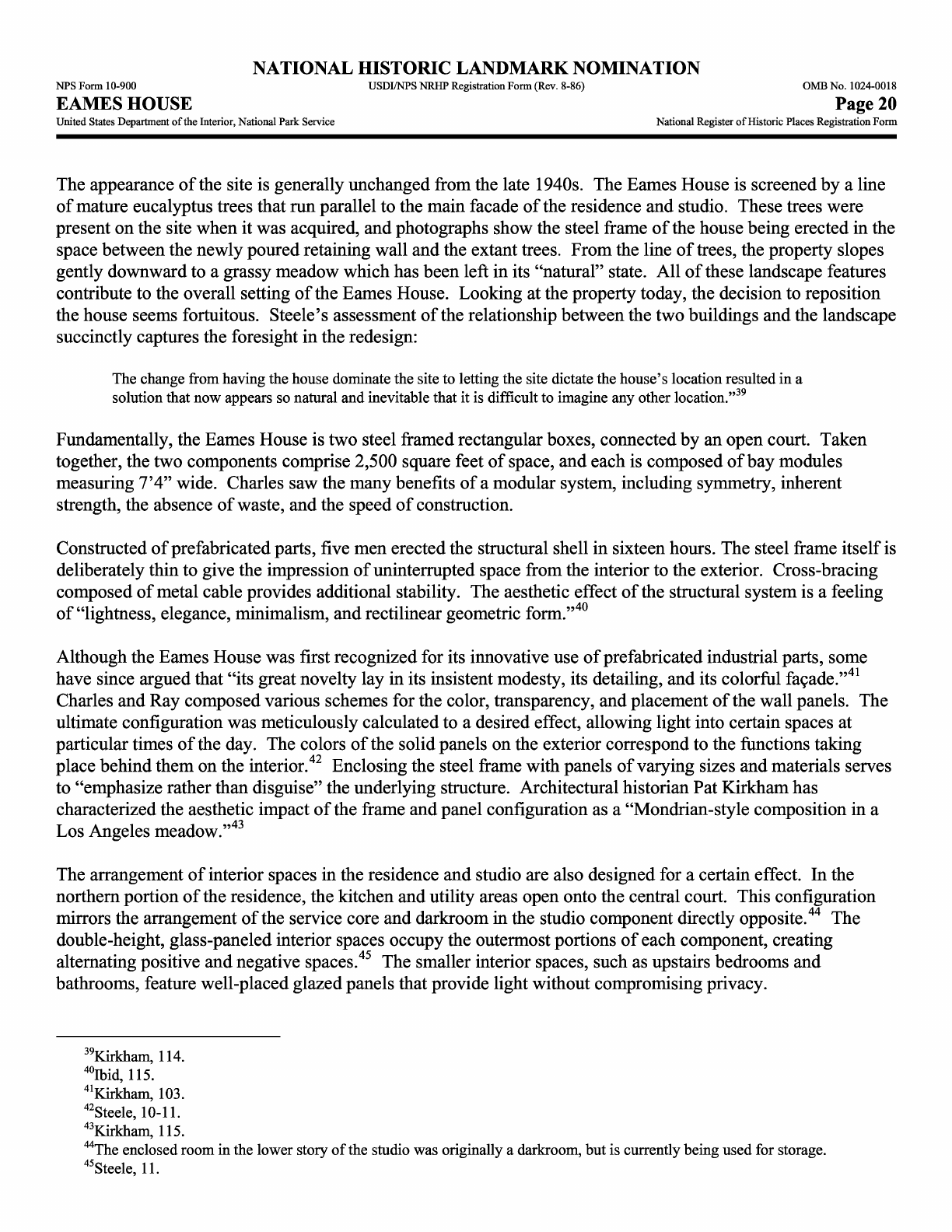
NATIONAL
HISTORIC
LANDMARK
NOMINATION
NFS
Form
10-900
USDI/NPS
NRHP
Registration
Form
(Rev.
8-86)
OMB
No.
1024-0018
EAMES
HOUSE
Page
20
United
States
Department
of
the
Interior,
National
Park
Service
National
Register
of
Historic
Places
Registration
Form
The
appearance
of
the
site
is
generally
unchanged
from
the
late
1940s.
The
Eames
House
is
screened
by
a
line
of
mature
eucalyptus trees
that
run
parallel
to
the
main
facade
of
the
residence
and
studio.
These trees
were
present
on
the
site
when
it
was acquired,
and photographs
show
the
steel
frame
of
the
house
being
erected
in
the
space
between
the
newly
poured
retaining
wall
and
the
extant
trees.
From
the line
of
trees,
the
property
slopes
gently
downward
to
a
grassy
meadow
which
has
been
left
in
its
"natural"
state.
All
of
these
landscape
features
contribute
to
the
overall
setting
of
the
Eames
House.
Looking
at
the
property
today, the
decision
to
reposition
the
house
seems
fortuitous.
Steele's
assessment
of
the
relationship
between
the
two
buildings
and
the
landscape
succinctly
captures
the
foresight
in
the redesign:
The
change
from
having
the
house
dominate
the
site
to
letting the
site
dictate
the
house's
location
resulted
in
a
solution
that
now
appears
so
natural
and
inevitable
that
it
is
difficult
to
imagine
any
other
location."
39
Fundamentally,
the
Eames
House
is
two
steel
framed
rectangular
boxes,
connected
by
an
open
court.
Taken
together,
the
two
components
comprise
2,500
square
feet
of
space,
and
each
is
composed
of
bay
modules
measuring
7'4"
wide.
Charles
saw
the
many
benefits
of
a
modular
system,
including
symmetry,
inherent
strength,
the
absence
of
waste,
and
the
speed
of
construction.
Constructed
of
prefabricated
parts,
five
men erected
the
structural
shell
in
sixteen
hours.
The
steel
frame
itself
is
deliberately
thin
to
give
the
impression
of
uninterrupted
space
from
the
interior
to
the
exterior.
Cross-bracing
composed
of
metal
cable
provides
additional
stability.
The
aesthetic
effect
of
the
structural
system
is
a
feeling
of
"lightness,
elegance,
minimalism,
and
rectilinear
geometric
form."
40
Although
the
Eames
House
was
first
recognized
for
its
innovative
use
of
prefabricated
industrial
parts,
some
have
since
argued
that
"its
great
novelty
lay
in
its
insistent
modesty,
its
detailing,
and
its
colorful
fasade."
41
Charles
and
Ray
composed
various
schemes
for
the
color,
transparency,
and
placement
of
the
wall
panels.
The
ultimate
configuration
was
meticulously
calculated
to
a
desired
effect,
allowing light
into
certain
spaces
at
particular
times
of
the
day.
The
colors
of
the
solid
panels
on
the
exterior
correspond
to
the
functions
taking
place
behind
them
on
the
interior.
42
Enclosing
the
steel
frame
with
panels
of
varying
sizes
and
materials
serves
to
"emphasize
rather than
disguise"
the
underlying
structure.
Architectural
historian
Pat
Kirkham
has
characterized
the
aesthetic
impact
of
the
frame
and
panel
configuration
as
a
"Mondrian-style
composition
in
a
Los
Angeles
meadow."
43
The
arrangement
of
interior
spaces
in
the
residence
and
studio
are
also
designed
for
a
certain
effect.
In
the
northern
portion
of
the
residence,
the
kitchen
and
utility
areas
open
onto
the
central
court.
This
configuration
mirrors
the
arrangement
of
the
service
core
and
darkroom
in
the studio
component
directly
opposite.
44
The
double-height,
glass-paneled
interior
spaces
occupy
the
outermost
portions
of
each
component,
creating
alternating
positive
and
negative
spaces.
45
The
smaller
interior
spaces,
such
as
upstairs bedrooms
and
bathrooms,
feature
well-placed glazed
panels
that
provide
light
without
compromising
privacy.
39
Kirkham,
114.
40
Ibid,
115.
41
Kirkham,
103.
42
Steele,
10-11.
43
Kirkham,
115.
44
The
enclosed
room
in
the
lower
story
of
the
studio
was
originally
a
darkroom,
but
is
currently
being
used
for
storage.
45
Steele,
11.
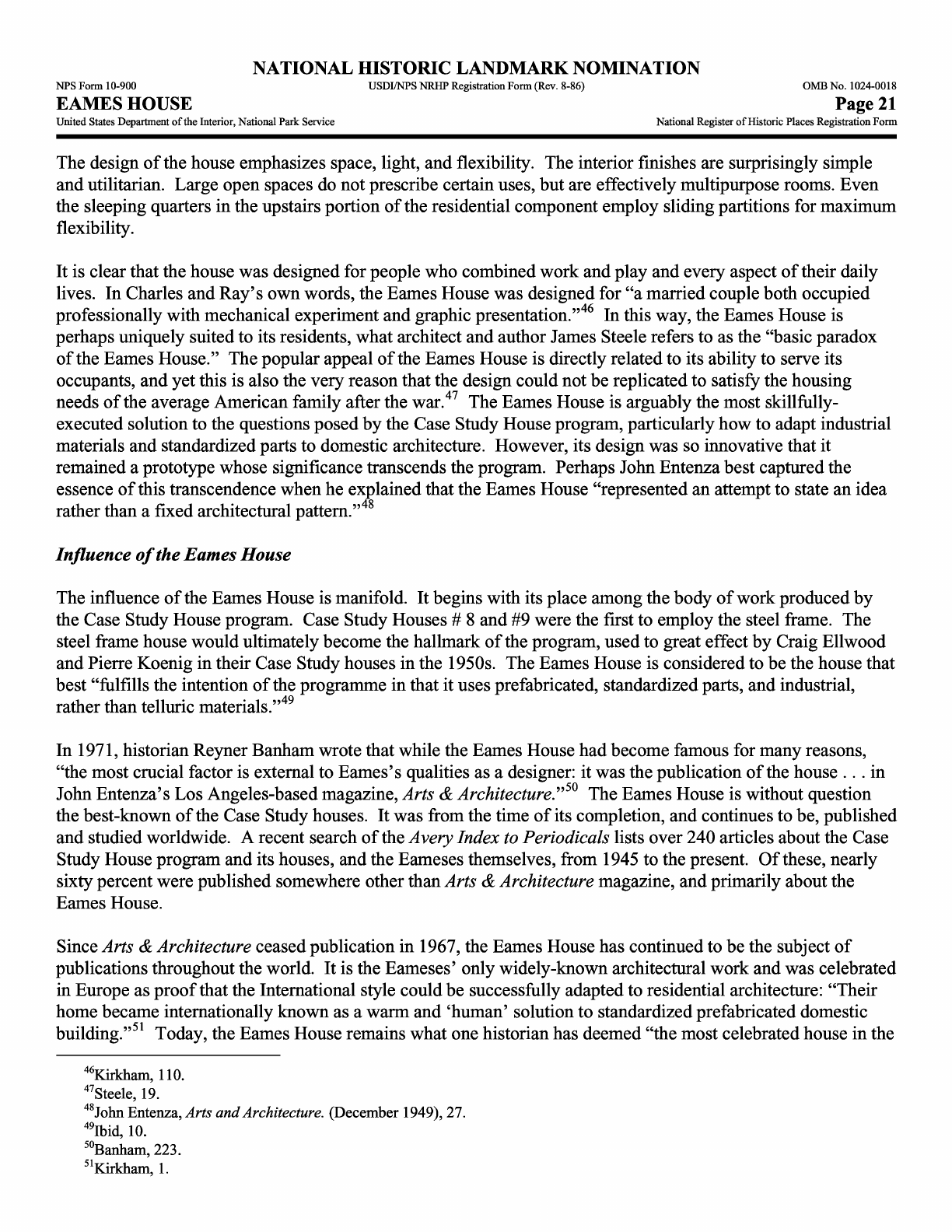
NATIONAL
HISTORIC
LANDMARK
NOMINATION
NFS
Form
10-900
USDI/NPS
NRHP
Registration
Form
(Rev.
8-86)
OMB
No.
1024-0018
EAMES
HOUSE
Page
21
United
States
Department
of
the
Interior,
National
Park
Service
National
Register
of
Historic
Places
Registration
Form
The
design
of
the
house
emphasizes
space,
light,
and
flexibility.
The
interior
finishes
are
surprisingly
simple
and
utilitarian.
Large
open
spaces
do
not
prescribe
certain
uses,
but
are
effectively
multipurpose
rooms.
Even
the
sleeping
quarters
in
the
upstairs
portion
of
the
residential
component
employ
sliding
partitions
for
maximum
flexibility.
It
is
clear
that
the
house
was
designed
for
people
who
combined
work
and
play
and
every
aspect
of
their
daily
lives.
In
Charles
and
Ray's
own
words,
the
Eames
House
was
designed
for
"a
married
couple
both
occupied
professionally
with
mechanical
experiment
and
graphic
presentation."
46
In
this
way,
the
Eames
House
is
perhaps uniquely
suited
to
its
residents,
what
architect
and author
James
Steele
refers
to
as
the
"basic
paradox
of
the
Eames
House."
The
popular
appeal
of
the
Eames
House
is
directly
related
to
its
ability
to
serve
its
occupants,
and
yet
this
is
also
the
very
reason
that
the
design
could
not
be
replicated
to satisfy the
housing
needs
of
the
average
American
family
after
the
war.
47
The
Eames
House
is
arguably
the
most
skillfully-
executed
solution
to
the
questions
posed
by
the
Case
Study
House
program,
particularly
how
to
adapt
industrial
materials
and standardized
parts
to
domestic architecture.
However,
its
design
was
so
innovative
that
it
remained
a
prototype
whose significance
transcends
the
program.
Perhaps
John
Entenza
best
captured
the
essence
of
this
transcendence
when
he
explained that
the
Eames
House
"represented
an
attempt
to
state
an
idea
rather
than
a
fixed architectural
pattern."
48
Influence
of
the
Eames
House
The
influence
of
the
Eames
House
is
manifold. It
begins
with
its
place
among
the
body
of
work
produced
by
the
Case
Study
House
program.
Case
Study
Houses
#
8
and
#9
were
the
first
to
employ
the
steel
frame. The
steel
frame
house
would
ultimately
become
the
hallmark
of
the
program,
used
to
great
effect
by
Craig
Ellwood
and
Pierre
Koenig
in
their
Case
Study
houses
in
the
1950s.
The
Eames
House
is
considered
to
be
the
house
that
best
"fulfills
the
intention
of
the
programme
in
that
it
uses
prefabricated,
standardized
parts,
and
industrial,
rather
than
telluric
materials."
49
In
1971,
historian Reyner
Banham wrote
that
while
the
Eames
House
had
become
famous
for
many
reasons,
"the
most
crucial
factor
is
external
to
Eames's
qualities
as
a
designer:
it
was
the
publication
of
the
house
...
in
John
Entenza's
Los
Angeles-based
magazine,
Arts
&
Architecture."
50
The
Eames
House
is
without
question
the
best-known
of
the
Case
Study
houses.
It
was
from
the
time
of
its
completion,
and
continues
to
be,
published
and
studied
worldwide.
A
recent
search
of
the
Avery
Index
to
Periodicals
lists
over
240
articles about
the
Case
Study
House
program
and
its
houses,
and
the
Eameses themselves,
from
1945
to
the
present.
Of
these,
nearly
sixty
percent
were
published
somewhere
other
than
Arts
&
Architecture
magazine,
and
primarily
about
the
Eames
House.
Since
Arts
&
Architecture
ceased
publication
in
1967,
the
Eames
House
has
continued
to
be
the
subject
of
publications
throughout
the world.
It
is
the
Eameses'
only
widely-known
architectural
work
and
was
celebrated
in
Europe
as
proof
that
the
International
style
could
be
successfully
adapted
to
residential
architecture:
"Their
home
became
internationally
known
as
a
warm
and
'human'
solution
to
standardized
prefabricated
domestic
building."
51
Today,
the
Eames
House
remains
what
one
historian
has
deemed
"the most
celebrated
house
in
the
46
Kirkham,
110.
47
Steele,
19.
48
John
Entenza,
Arts
and
Architecture.
(December
1949),
27.
49
Ibid,
10.
50
T
"Banham,
223.
51
Kirkham,
1.
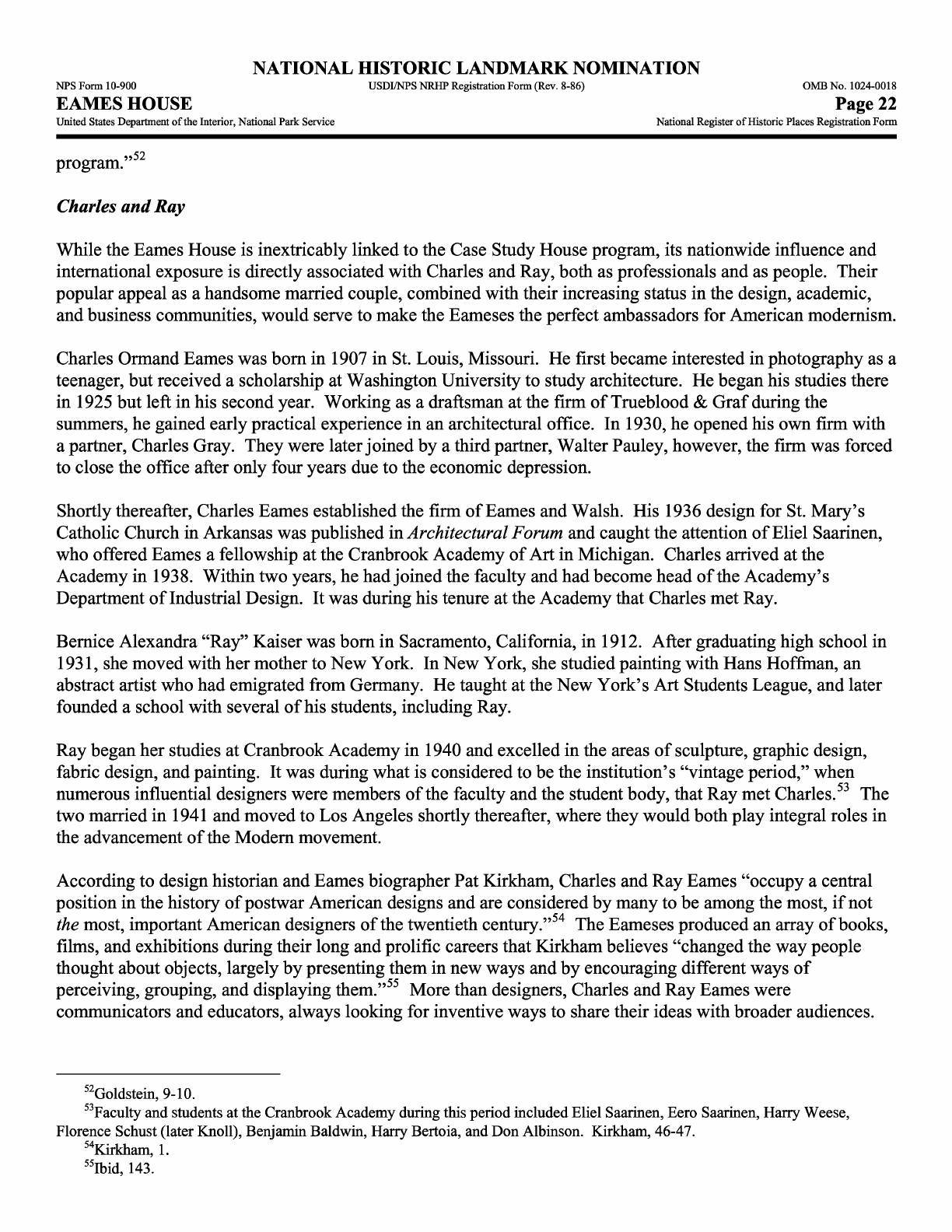
NATIONAL
HISTORIC
LANDMARK
NOMINATION
NFS
Form
10-900
USDI/NPS
NRHP
Registration
Form
(Rev.
8-86)
OMB
No.
1024-0018
EAMES HOUSE
Page
22
United
States
Department
of
the
Interior,
National
Park
Service
National
Register
of
Historic
Places
Registration
Form
program."
52
Charles
and Ray
While
the
Eames
House
is
inextricably
linked
to
the
Case
Study
House
program,
its
nationwide
influence
and
international
exposure
is
directly
associated
with
Charles
and
Ray,
both
as
professionals and
as
people.
Their
popular
appeal
as
a
handsome
married
couple,
combined with
their
increasing
status
in
the
design,
academic,
and
business
communities,
would
serve
to
make
the
Eameses
the
perfect
ambassadors
for
American
modernism.
Charles
Ormand
Eames was
born
in
1907
in
St.
Louis,
Missouri.
He
first
became
interested
in
photography
as
a
teenager,
but
received
a
scholarship
at
Washington
University
to study architecture.
He
began
his
studies
there
in
1925
but
left
in
his
second
year.
Working
as
a
draftsman
at
the
firm
of
Trueblood
&
Graf
during the
summers,
he
gained
early
practical
experience
in
an
architectural
office.
In
1930,
he
opened
his
own
firm
with
a
partner,
Charles
Gray.
They
were
later
joined
by
a
third
partner,
Walter
Pauley,
however,
the
firm
was
forced
to
close
the
office
after
only
four
years
due
to
the
economic
depression.
Shortly
thereafter,
Charles
Eames
established
the
firm
of
Eames
and
Walsh.
His
1936
design
for
St.
Mary's
Catholic
Church
in
Arkansas
was
published
in
Architectural
Forum
and
caught
the
attention
of
Eliel
Saarinen,
who
offered
Eames
a
fellowship
at
the
Cranbrook
Academy
of
Art
in
Michigan.
Charles
arrived
at
the
Academy
in
1938.
Within
two
years, he
had
joined
the
faculty
and
had
become
head
of
the
Academy's
Department
of
Industrial
Design.
It
was
during
his
tenure
at
the
Academy
that
Charles
met
Ray.
Bernice
Alexandra
"Ray"
Kaiser
was
born
in
Sacramento,
California,
in
1912.
After
graduating high
school
in
1931,
she
moved
with
her
mother
to
New
York.
In
New
York,
she
studied
painting
with
Hans
Hoffman,
an
abstract
artist
who
had
emigrated
from
Germany.
He
taught
at
the
New
York's
Art
Students
League,
and
later
founded
a
school
with
several
of
his students,
including
Ray.
Ray
began
her
studies at
Cranbrook
Academy
in
1940
and
excelled
in
the
areas
of
sculpture,
graphic
design,
fabric
design,
and painting.
It
was
during
what
is
considered
to
be
the
institution's
"vintage
period,"
when
numerous influential
designers
were
members
of
the
faculty
and
the
student body,
that
Ray
met
Charles.
53
The
two
married
in
1941
and
moved
to
Los
Angeles shortly
thereafter,
where
they
would
both
play
integral roles
in
the
advancement
of
the
Modern
movement.
According
to
design
historian
and
Eames
biographer
Pat
Kirkham,
Charles
and
Ray
Eames
"occupy
a
central
position
in
the
history
of
postwar
American
designs
and
are
considered
by
many
to
be
among
the
most,
if
not
the
most,
important
American
designers
of
the
twentieth
century."
54
The
Eameses
produced
an
array
of
books,
films,
and
exhibitions during
their
long
and
prolific
careers
that
Kirkham
believes
"changed
the
way
people
thought
about
objects,
largely
by
presenting them
in
new
ways
and
by
encouraging different
ways
of
perceiving,
grouping,
and
displaying
them."
55
More
than
designers,
Charles
and
Ray
Eames
were
communicators and
educators,
always
looking
for
inventive
ways
to
share
their
ideas
with
broader
audiences.
52
Goldstein,
9-10.
53
Faculty
and
students
at
the
Cranbrook
Academy
during
this
period
included
Eliel
Saarinen,
Eero
Saarinen,
Harry
Weese,
Florence
Schust
(later
Knoll),
Benjamin
Baldwin,
Harry
Bertoia,
and
Don
Albinson.
Kirkham,
46-47.
54
Kirkham,
1.
55
Ibid,
143.
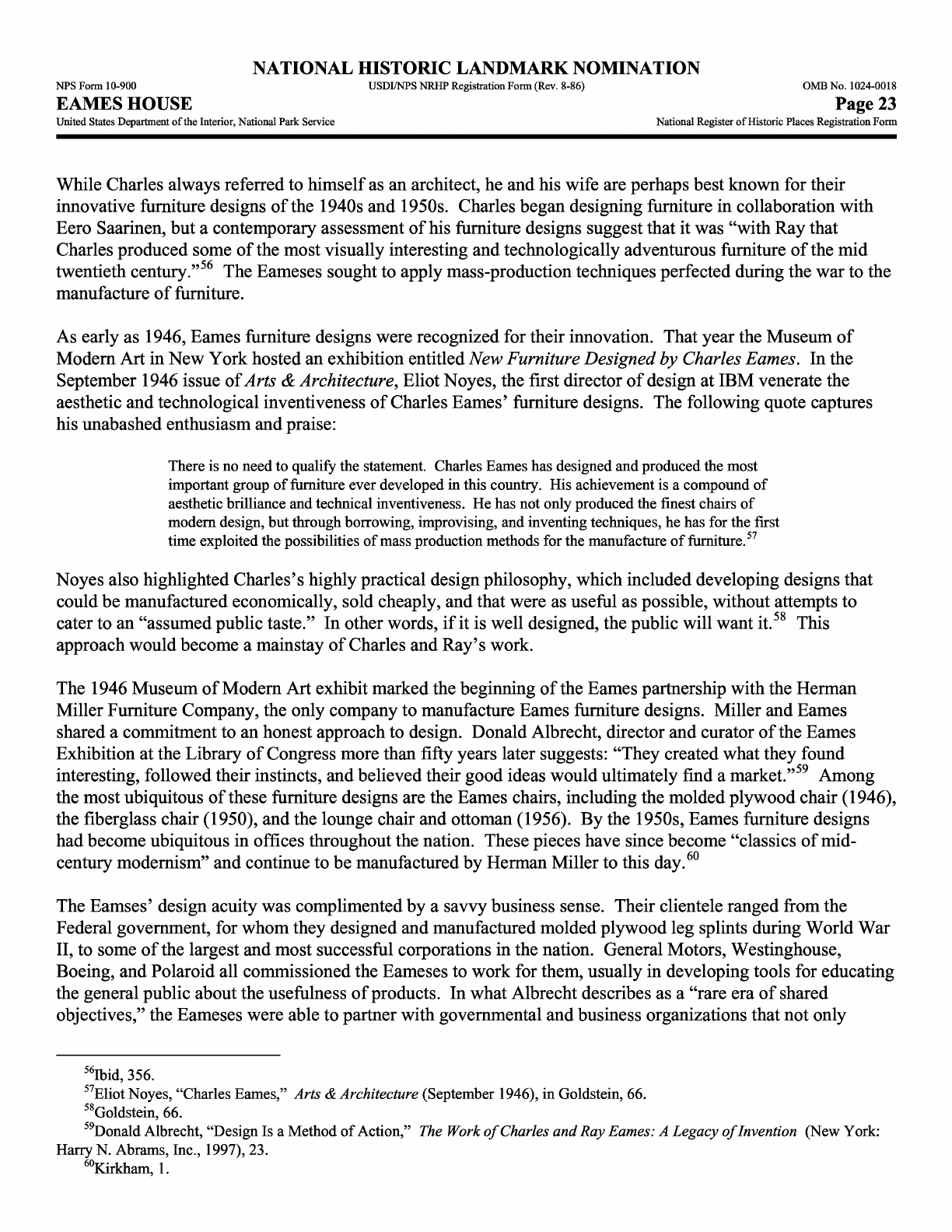
NATIONAL
HISTORIC
LANDMARK
NOMINATION
NFS
Form
10-900
USDI/NPS
MRHP
Registration
Form
(Rev.
8-86)
OMB
No.
1024-0018
EAMES
HOUSE
Page
23
United
States
Department
of
the
Interior,
National
Park
Service
National
Register
of
Historic
Places
Registration
Form
While
Charles
always
referred
to
himself
as
an
architect,
he
and
his
wife
are
perhaps
best
known
for
their
innovative
furniture
designs
of
the
1940s
and
1950s.
Charles
began
designing furniture
in
collaboration
with
Eero
Saarinen,
but
a
contemporary
assessment
of
his
furniture
designs
suggest
that
it
was
"with
Ray
that
Charles
produced
some
of
the
most
visually
interesting
and
technologically
adventurous
furniture
of
the
mid
twentieth
century."
56
The
Eameses
sought
to
apply
mass-production
techniques
perfected
during the
war
to
the
manufacture
of
furniture.
As
early
as
1946,
Eames
furniture
designs
were
recognized
for
their
innovation.
That
year
the
Museum
of
Modern
Art
in
New
York
hosted
an
exhibition entitled
New
Furniture
Designed
by
Charles
Eames.
In
the
September
1946
issue
of
Arts
&
Architecture,
Eliot Noyes,
the
first
director
of
design
at IBM
venerate
the
aesthetic
and
technological
inventiveness
of
Charles
Eames'
furniture
designs.
The
following
quote
captures
his
unabashed
enthusiasm
and
praise:
There
is
no
need
to
qualify
the
statement.
Charles
Eames has
designed and
produced
the
most
important
group
of
furniture ever
developed
in
this
country.
His
achievement
is
a
compound
of
aesthetic
brilliance
and
technical
inventiveness.
He
has
not
only
produced
the
finest
chairs
of
modern
design,
but
through
borrowing,
improvising,
and
inventing
techniques,
he has
for
the
first
time
exploited
the
possibilities
of
mass
production
methods
for
the
manufacture
of
furniture.
57
Noyes
also
highlighted
Charles's
highly
practical
design philosophy,
which
included
developing
designs
that
could
be manufactured
economically,
sold
cheaply,
and
that
were
as
useful
as
possible,
without
attempts to
cater
to
an
"assumed
public
taste."
In
other
words,
if
it
is
well
designed,
the
public
will
want
it.
58
This
approach
would
become
a
mainstay
of
Charles
and
Ray's
work.
The
1946
Museum
of
Modern
Art
exhibit
marked
the
beginning
of
the
Eames
partnership
with
the
Herman
Miller
Furniture
Company, the
only company
to
manufacture
Eames
furniture
designs.
Miller
and
Eames
shared
a
commitment
to
an
honest
approach
to design.
Donald
Albrecht,
director
and
curator
of
the
Eames
Exhibition
at
the
Library
of
Congress
more
than
fifty
years
later
suggests:
"They
created
what
they
found
interesting,
followed
their
instincts, and
believed
their
good
ideas
would
ultimately
find
a
market."
59
Among
the
most
ubiquitous
of
these
furniture designs
are
the
Eames
chairs,
including
the
molded
plywood
chair
(1946),
the
fiberglass
chair
(1950),
and
the
lounge
chair
and
ottoman
(1956).
By
the
1950s,
Eames
furniture designs
had
become
ubiquitous
in
offices
throughout
the nation.
These
pieces
have
since
become
"classics
of
mid-
century
modernism"
and
continue to
be manufactured
by
Herman
Miller
to
this
day.
60
The
Eamses'
design acuity
was
complimented
by
a
savvy
business
sense.
Their
clientele
ranged
from
the
Federal
government,
for
whom they
designed
and
manufactured
molded
plywood
leg splints
during
World
War
II,
to
some
of
the
largest
and
most
successful
corporations
in
the
nation.
General
Motors,
Westinghouse,
Boeing,
and
Polaroid
all
commissioned
the
Eameses
to
work
for
them,
usually
in
developing
tools
for
educating
the
general
public
about
the
usefulness
of
products.
In
what Albrecht
describes
as
a
"rare
era
of
shared
objectives,"
the
Eameses
were
able
to
partner
with
governmental
and
business
organizations
that not
only
56
Ibid,
356.
57
Eliot
Noyes,
"Charles
Eames,"
Arts
&
Architecture
(September
1946),
in
Goldstein,
66.
58
Goldstein,
66.
59
Donald
Albrecht,
"Design
Is
a
Method
of
Action,"
The
Work
of
Charles
and
Ray
Eames:
A
Legacy
of
Invention
(New
York:
Harry
N.
Abrams,
Inc.,
1997),
23.
60
Kirkham,
1.

NATIONAL
HISTORIC
LANDMARK
NOMINATION
NFS
Form
10-900
USDI/NPS
MRHP
Registration
Form
(Rev.
8-86)
OMB
No.
1024-0018
EAMES
HOUSE
Page
24
United
States
Department
of
the
Interior,
National
Park
Service
National
Register
of
Historic
Places
Registration
Form
admired
their
vision
of
a
modernized
postwar
America,
but
as
Albrecht
further
indicates,
also
possessed
the
"political,
financial,
and
technological
capabilities
to
realize
their
vision."
61
These
partnerships
proved
mutually
beneficial,
and
increasingly exposed
a
broader
sector
of
the
public
to
the
Eameses and
their
work.
Beginning
in
the
1950s,
Charles
and
Ray
Eames
directed
their
energy
toward
mass
communication,
through
innovative exhibitions, installations,
publications,
and
films.
Their
books,
multi-screen
slide
shows,
films,
and
interactive
museum
exhibitions
covered
a
wide
range
of
subjects.
These
works
were
cast
to
help
people
understand
and
engage
the
everyday
world
both
nearby
and
afar.
Their
"India
Report"
(1958),
commissioned
by
the
Indian
government;
Glimpses
of
the
USA
(1959),
a
multi-screen
film;
the
Mathematica:
A
World
of
Numbers
and Beyond
exhibit
(1961);
and
"The
World
of
Franklin
and
Jefferson"
(1976),
a
traveling
exhibition
commissioned
by
the
American
Revolution
Bicentennial Administration,
are
among
their
most
complex,
ambitious,
and
best
known
mass
communication
projects.
62
The
impact
of
these
projects
could
be
far
reaching,
as
illustrated
in
the
following
excerpt:
The
Eamses'
"India
Report"
...
contained
recommendations
for
industrializing and making
mass-prodcuced
goods
without
losing
the
qualities
of
the
country's
traditional
handicrafts.
Among
the
Eamses'
recommendations
was
the
establishment
of
a
government-supported
design
institute
which
would
foster
India's
development
as
the
country
underwent
revolutionary
changes
and
would
help
small
industries
produce
consumer
goods.
As
a
result
of
the
Eameses
report,
the
National
Institutue
of
Design
was
established
in
1961
in
Ahmedabad,
the
institution for
industrial
design,
education,
and
training in
the
developing
world.
63
Charles
and Ray
Eames
brought
the
same
focus
and
aim
to
their
smaller works
as
well.
Two
of
their
short
films,
Toccata
for
Toy
Trains
(1957)
and
Tops
(1969),
further
reflect
the
Eameses'
belief
in
the
value
and
educational
role
of
ordinary
objects. In
the
two
films,
Charles
and Ray
used their
personal
collection
of
toys
gathered
in
their
world
travels
to
create
a
visual
experience
of
the
principles
of
design
and
thus
an
accessible
understanding.
During
this
same
period,
the Eamses
started
to
receive
commissions
from
corporations
to
develop
films
and
exhibitions
that
would
introduce
new
technologies
to
the
general
public.
In
the
1970s,
the
Eameses
produced
a
number
of
films
for
Polaroid,
marketing
the
idea
of
instant
cameras.
However,
the
most
enduring
and lucrative
of
these
corporate
partnerships
was
with
International
Business
Machines
(IBM).
The
Eameses
began
working
with
IBM
in
1958.
Over
the
next
two
decades,
Charles
and
Ray
produced
some
fifty
exhibitions,
books,
and
films
designed
to
"demystify
concepts
of
science
and
mathematics
and
familiarize
the
public
with
computers."
64
With
the
financial
support
of
IBM,
the
Eameses'
presentations
became
more complex,
including
multi-screen
slide
shows
and
films
designed
to
"engage
the
visitor's
interest."
65
The
1960
Mathematica
exhibition
was
funded
by
IBM
for
the
California
Museum
of
Science
and
Industry's
opening
of
a
new
wing.
The
Eameses
also
designed
the
22-screen
Think
for
the
IBM
pavilion
at
the
1964
New
York
World's
Fair.
Perhaps
the
work that
best
illustrates
the
Eameses'
ability
to make
science
interesting
and
accessible
is
Powers
of
Ten:
A
Film
Dealing
with
the
Relative
Size
of
Things
in
the
Universe
and
the
Effect
of
Adding
Another
Zero,
first
produced
in
1968.
The
film
begins
with
an
overhead
shot
of
a
man lying
in
a
park;
then,
as
described
by
architectural
historian,
Pat
Kirkham:
61
Albrecht,
13.
62
Steele,
24.
Library
of
Congress,
"The
Work
of
Charles
&
Ray
Eames,
Exhibition,"
[http:www.loc.gov/exhibits/eames/culture.html
(September
22,
2005)]
63
Library
of
Congress,
"The
Work
of
Charles
&
Ray
Eames,
Exhibition."
64
Ibid,
15.
65
Kirkham,
266.

NATIONAL
HISTORIC
LANDMARK
NOMINATION
NFS
Form
10-900
USDI/NPS
MRHP
Registration
Form
(Rev.
8-86)
OMB
No.
1024-0018
EAMES
HOUSE
Page
25
United
States
Department
of
the
Interior,
National
Park
Service
National
Register
of
Historic
Places
Registration
Form
Using
a
continuous
zoom,
the
film
takes
the
viewer
out from
the
Earth
to
the
farthest
known
point
in space
and
then
back
to the
nucleus
of
a
carbon atom
while
chronometers
on
a
split
screen
register
distance
traveled
at
the
rate
of
one
power
often
every
ten
seconds.
66
Powers
of
Ten
has
been
used
widely
in
schools
and
science
museums
as
an
educational
tool,
and
it
is
yet
another
example
of
the
sheer
scope
of
the
Eameses'
careers.
Donald
Albrecht
succinctly
captured
the
breadth
of
their
work
with
the
assessment
that
"Charles and
Ray
Eames
started
by
designing
a
simple
molded-plywood
chair,
and
they
ended
by
tackling
the
challenge
of
explaining
the
nature
of
the
universe."
67
These
highly
effective tools
for
learning
also
greatly
increased
the
public's
awareness
of
Charles
and
Ray
Eames,
both
nationally
and
globally.
The
seven-screen
film,
Glimpses
of
the
U.S.A.
had
been
designed
to
present
a
positive
portrayal
of
American
life
at
the
1959
American
National Exhibition
in Moscow.
Kirkham
has
characterized
the showing
of
the
film
as
"the
first cultural
exchange
between
the
two
countries
since
the
Bolshevik
Revolution."
68
The
World
of
Franklin
and
Jefferson,
celebrating
the
American
Bicentennial,
produced
a
book,
three
films,
and
an
exhibition
that traveled
internationally.
Because
of
such
projects,
Charles
and
Ray
became well
known
not
only
throughout
the
United
States,
but
in
Western
Europe,
Japan,
and
India.
69
In
all,
Charles
and
Ray
produced
eighty
short
films,
plus
dozens
of
books,
museum
exhibitions,
and
education
tools
of
all
kinds.
All
of
these
projects
served
to
spread
their
enthusiasm
for
a
modern
future
beyond
the
realm
of
designers
and
academics,
and
into
the
mainstream.
The
Eameses
were
at
the
forefront
of
the
postwar
Modernist
movement
in
the
United
States,
and did
more
than
any
other individuals
to
bring
American
modernism
to
the
rest
of
the
world.
Their
furniture,
toys,
buildings,
films,
exhibitions,
and
books
were
all
aimed
at
improving
the
lives
of
average
people.
Donald
Albrecht,
director
of
the
2001
Eames
Exhibiton
at
the
Library
of
Congress,
has
argued
that
"Charles
Eames
(1907-78)
and
Ray
Eames
(1912-88)
gave
shape
to
America's
twentieth
century;
their
projects
"elevated
the
Eameses
to
the
status
of
U.S.
ambassadors overseas
HC\
and
cultural
interpreters
of
the
meaning
of
America
at
home."
Eames-Associated
Sites
The
Eames
House
is
the
single
property
most
closely
associated
with
Charles
and Ray
Eames.
Not
only
is
it
one
of
the
few
architectural
works
designed
by
Charles Eames,
but
the
property
served
as
the
couple's
private
residence and
design
studio
throughout
their
prolific
careers.
Only
a
handful
of
other
properties
bear
an
association
with
the
Eameses.
A
unit
in
the Strathmore
Apartments
in
the
Westwood
neighborhood
of
Los
Angeles
was
the
couple's
first
home
upon
arriving
in
California
in
1941.
Designed
by Richard
Neutra
in
1937,
it
was
where
the
Eameses
lived
until
1949,
when
they
moved
into
their
newly
completed
home
in
Pacific
Palisades.
An
industrial
building
at
901
Washington
Boulevard
in
Venice,
California,
is
where
the
Eameses
and
their
staff
did
the
majority
of
their
productive/production
work
after
1943.
This
building
was
converted
for
use
as
the offices
of
architect
Frank
Israel
in
the
1980s,
which
has
affected
the
integrity
of
the
building
in
its
association
with
the
Eameses.
66
Ibid,
353.
67
Albrecht,41.
68
Ibid,
32.
69
Kirkham,
356.
70
Albrecht,
15;
and
{http://www.loc.gov/exhibits/eames
(September
22,
2005)]
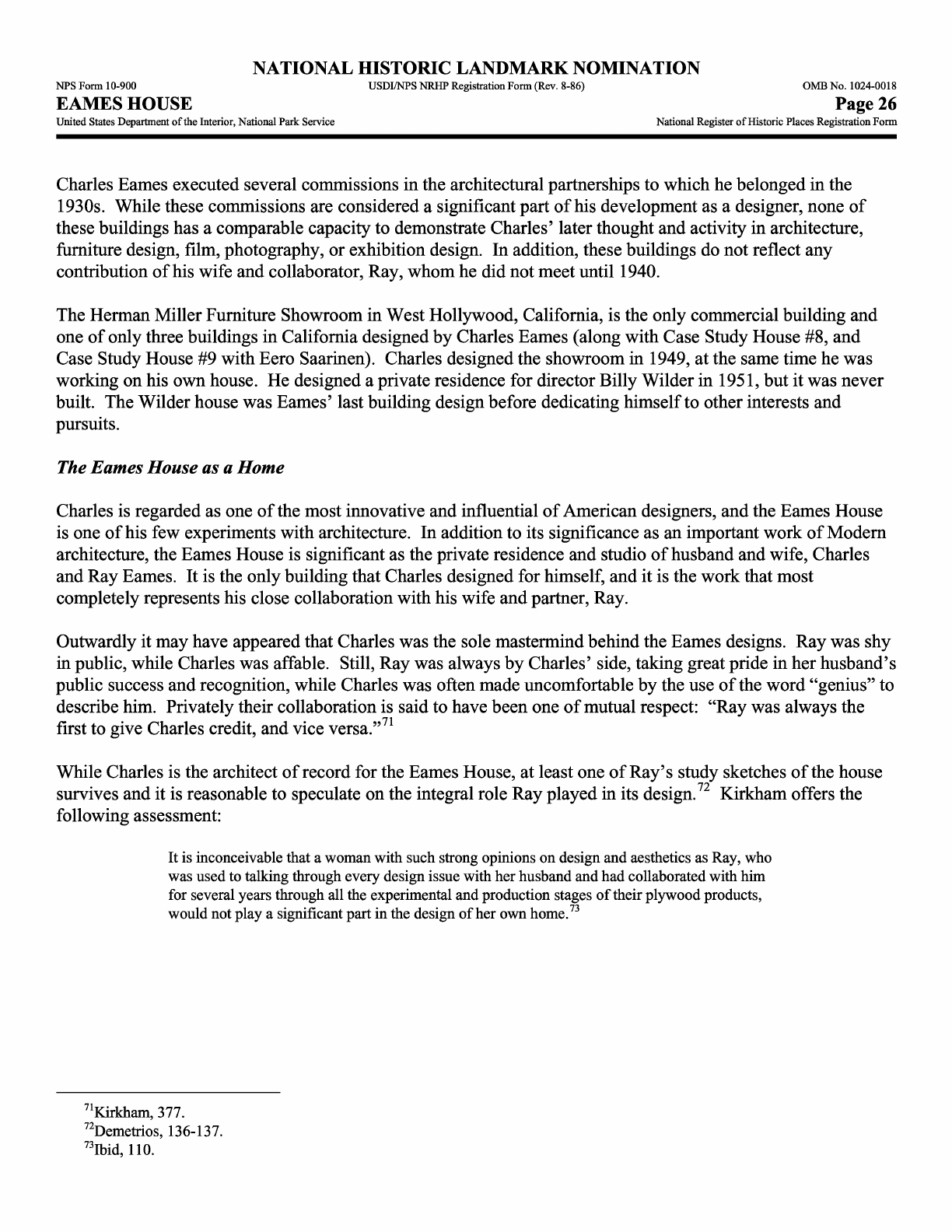
NATIONAL
HISTORIC
LANDMARK
NOMINATION
NFS
Form
10-900
USDI/NPS
NRHP
Registration
Form
(Rev.
8-86)
OMB
No.
1024-0018
EAMES
HOUSE
Page
26
United
States
Department
of
the
Interior,
National
Park
Service
National
Register
of
Historic
Places
Registration
Form
Charles
Eames
executed
several
commissions
in
the
architectural
partnerships
to
which
he
belonged
in
the
1930s.
While
these
commissions
are
considered
a
significant
part
of
his
development
as
a
designer,
none
of
these
buildings
has
a
comparable
capacity
to
demonstrate
Charles'
later
thought
and
activity
in
architecture,
furniture
design,
film,
photography,
or
exhibition
design.
In
addition,
these
buildings
do
not
reflect
any
contribution
of
his
wife and
collaborator,
Ray,
whom
he
did
not
meet
until
1940.
The
Herman
Miller
Furniture
Showroom
in
West
Hollywood,
California,
is
the
only
commercial
building
and
one
of
only
three
buildings
in
California designed
by
Charles
Eames
(along
with
Case
Study
House
#8,
and
Case
Study
House
#9
with
Eero
Saarinen).
Charles
designed
the
showroom
in
1949,
at
the
same
time
he
was
working
on
his
own
house.
He
designed
a
private
residence
for
director
Billy
Wilder
in
1951,
but
it
was
never
built.
The
Wilder
house
was
Eames'
last
building
design
before
dedicating
himself
to
other
interests
and
pursuits.
The
Eames
House
as
a
Home
Charles
is
regarded
as
one
of
the
most
innovative
and
influential
of
American
designers,
and
the
Eames
House
is
one
of
his
few
experiments
with
architecture.
In
addition
to
its
significance
as
an
important
work
of
Modern
architecture,
the
Eames
House
is
significant
as
the
private residence
and
studio
of
husband
and
wife,
Charles
and
Ray
Eames.
It
is
the
only
building
that
Charles
designed
for
himself,
and it
is
the
work
that
most
completely represents
his
close
collaboration
with
his
wife
and
partner,
Ray.
Outwardly
it
may
have
appeared
that
Charles
was
the
sole
mastermind
behind
the
Eames
designs.
Ray
was
shy
in
public,
while
Charles
was
affable.
Still,
Ray
was
always
by
Charles'
side,
taking
great
pride
in
her
husband's
public
success
and
recognition,
while
Charles
was
often
made
uncomfortable
by
the
use
of
the
word
"genius"
to
describe
him.
Privately
their
collaboration
is
said
to
have
been
one
of
mutual
respect:
"Ray
was
always
the
first
to
give
Charles
credit,
and
vice
versa."
71
While Charles
is
the
architect
of
record
for
the
Eames
House,
at
least
one
of
Ray's
study sketches
of
the
house
survives
and
it
is
reasonable
to
speculate
on
the
integral
role
Ray
played
in
its
design.
72
Kirkham
offers
the
following
assessment:
It
is
inconceivable
that
a
woman with
such
strong
opinions
on
design
and
aesthetics
as
Ray,
who
was
used
to
talking
through
every
design
issue
with
her
husband
and
had
collaborated with
him
for
several
years
through
all
the
experimental
and
production
stages
of
their
plywood
products,
would
not play
a
significant
part
in
the
design
of
her
own
home.
73
71
Kirkham,
377.
72
Demetrios,
136-137.
73
T
110.
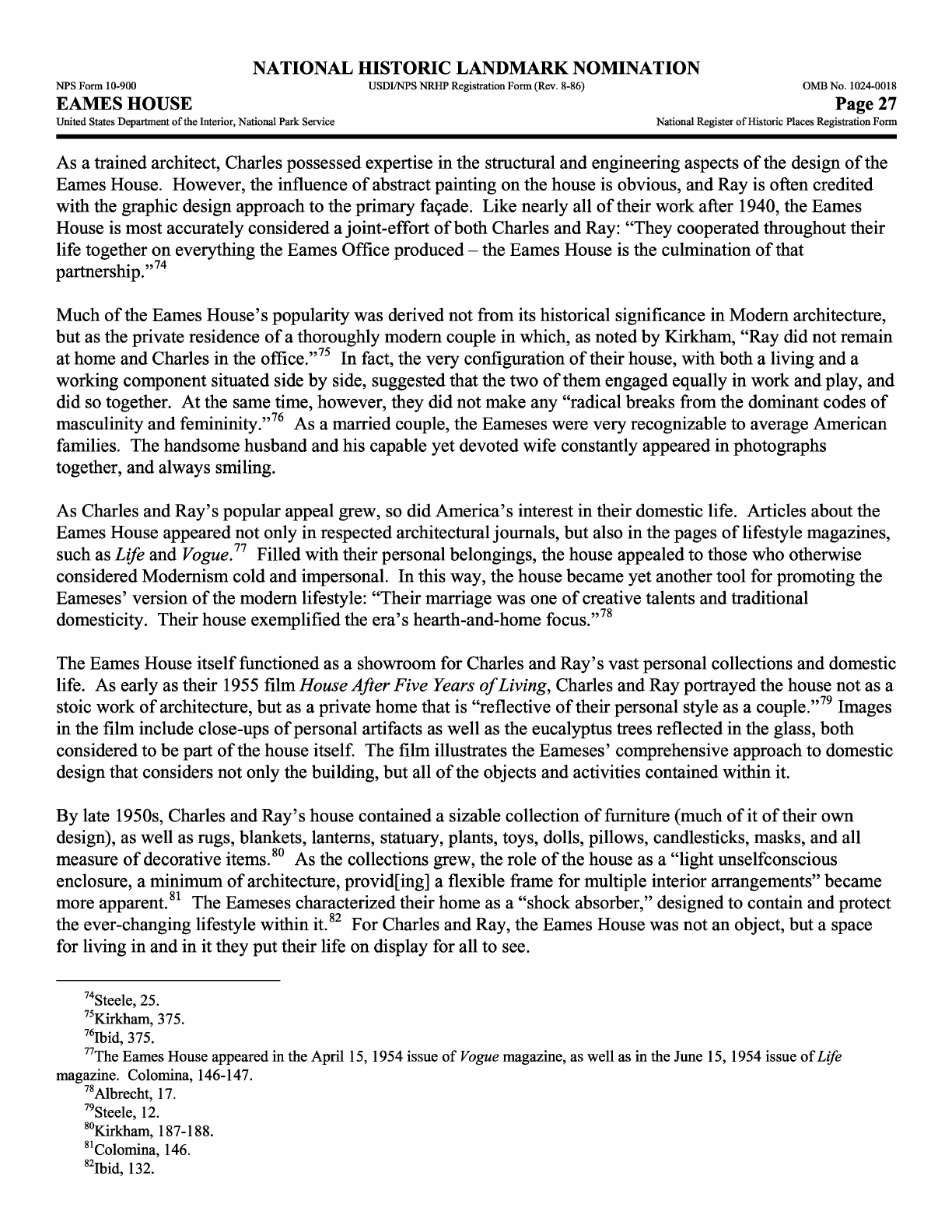
NATIONAL
HISTORIC
LANDMARK
NOMINATION
NFS
Form
10-900
USDI/NPS
NRHP
Registration
Form
(Rev.
8-86)
OMB
No.
1024-0018
EAMES
HOUSE
Page
27
United
States
Department
of
the
Interior,
National
Park
Service
National
Register
of
Historic
Places
Registration
Form
As
a
trained
architect, Charles
possessed
expertise
in
the
structural
and
engineering
aspects
of
the
design
of
the
Eames
House.
However,
the
influence
of
abstract
painting
on
the
house
is
obvious,
and
Ray
is
often
credited
with
the
graphic
design approach
to
the
primary
facade.
Like
nearly
all
of
their work
after
1940,
the
Eames
House
is
most
accurately
considered
a
joint-effort
of
both
Charles
and
Ray:
"They
cooperated
throughout
their
life
together
on everything
the
Eames
Office
produced
-
the
Eames
House
is
the
culmination
of
that
partnership."
74
Much
of
the
Eames
House's
popularity
was
derived
not
from
its
historical
significance
in
Modern
architecture,
but
as
the
private residence
of
a
thoroughly modern
couple
in
which,
as
noted
by
Kirkham,
"Ray
did
not
remain
rjr
at
home
and
Charles
in
the
office."
In
fact,
the
very
configuration
of
their
house,
with both
a
living
and
a
working
component
situated
side
by
side,
suggested
that
the
two
of
them
engaged
equally
in
work
and
play,
and
did
so
together.
At
the
same
time,
however,
they
did
not
make
any
"radical
breaks
from
the
dominant
codes
of
masculinity
and
femininity."
76
As
a
married
couple,
the
Eameses
were
very
recognizable
to
average
American
families.
The
handsome
husband
and
his
capable
yet
devoted
wife
constantly
appeared
in
photographs
together,
and
always
smiling.
As
Charles
and
Ray's
popular
appeal
grew,
so
did
America's
interest
in
their
domestic
life.
Articles
about
the
Eames
House
appeared
not
only
in
respected
architectural
journals,
but
also
in
the
pages
of
lifestyle
magazines,
such
as
Life
and
Vogue.
11
Filled
with
their
personal
belongings,
the
house
appealed
to
those
who
otherwise
considered
Modernism
cold
and
impersonal.
In
this
way,
the
house became
yet
another
tool
for
promoting
the
Eameses'
version
of
the
modern
lifestyle:
"Their
marriage
was
one
of
creative
talents
and
traditional
domesticity.
Their
house
exemplified
the
era's
hearth-and-home
focus."
78
The
Eames
House
itself
functioned
as
a
showroom
for
Charles
and
Ray's
vast
personal
collections
and
domestic
life.
As
early
as
their
1955
film
House
After
Five
Years
of
Living,
Charles
and
Ray
portrayed
the
house
not
as
a
stoic
work
of
architecture,
but
as
a
private
home
that
is
"reflective
of
their
personal
style
as
a
couple."
79
Images
in
the
film
include
close-ups
of
personal
artifacts
as
well
as
the
eucalyptus
trees
reflected
in
the
glass,
both
considered
to
be
part
of
the
house
itself.
The
film
illustrates
the
Eameses'
comprehensive
approach
to
domestic
design
that
considers
not
only
the
building,
but
all
of
the
objects
and
activities
contained
within
it.
By
late
1950s,
Charles
and
Ray's
house
contained
a
sizable
collection
of
furniture
(much
of
it
of
their
own
design),
as
well
as
rugs,
blankets,
lanterns,
statuary,
plants,
toys, dolls,
pillows, candlesticks,
masks,
and
all
measure
of
decorative
items.
80
As
the
collections
grew,
the
role
of
the
house
as
a
"light
unselfconscious
enclosure,
a
minimum
of
architecture,
providing]
a
flexible
frame
for
multiple
interior arrangements"
became
more
apparent.
81
The
Eameses
characterized
their
home
as
a
"shock
absorber,"
designed
to
contain
and
protect
the
ever-changing
lifestyle
within
it.
82
For
Charles
and
Ray,
the
Eames
House
was
not
an
object,
but
a
space
for
living
in
and
in
it
they
put
their
life
on
display
for
all
to
see.
74
Steele,
25.
75
Kirkham,
375.
76
Ibid,
375.
77
The
Eames
House
appeared
in
the
April
15,
1954
issue
of
Vogue
magazine,
as
well
as
in
the
June
15,
1954
issue
of
Life
magazine. Colomina,
146-147.
78
Albrecht,
17.
79
Steele,
12.
80
Kirkham,
187-188.
81
Colomina,
146.
82
Ibid,
132.
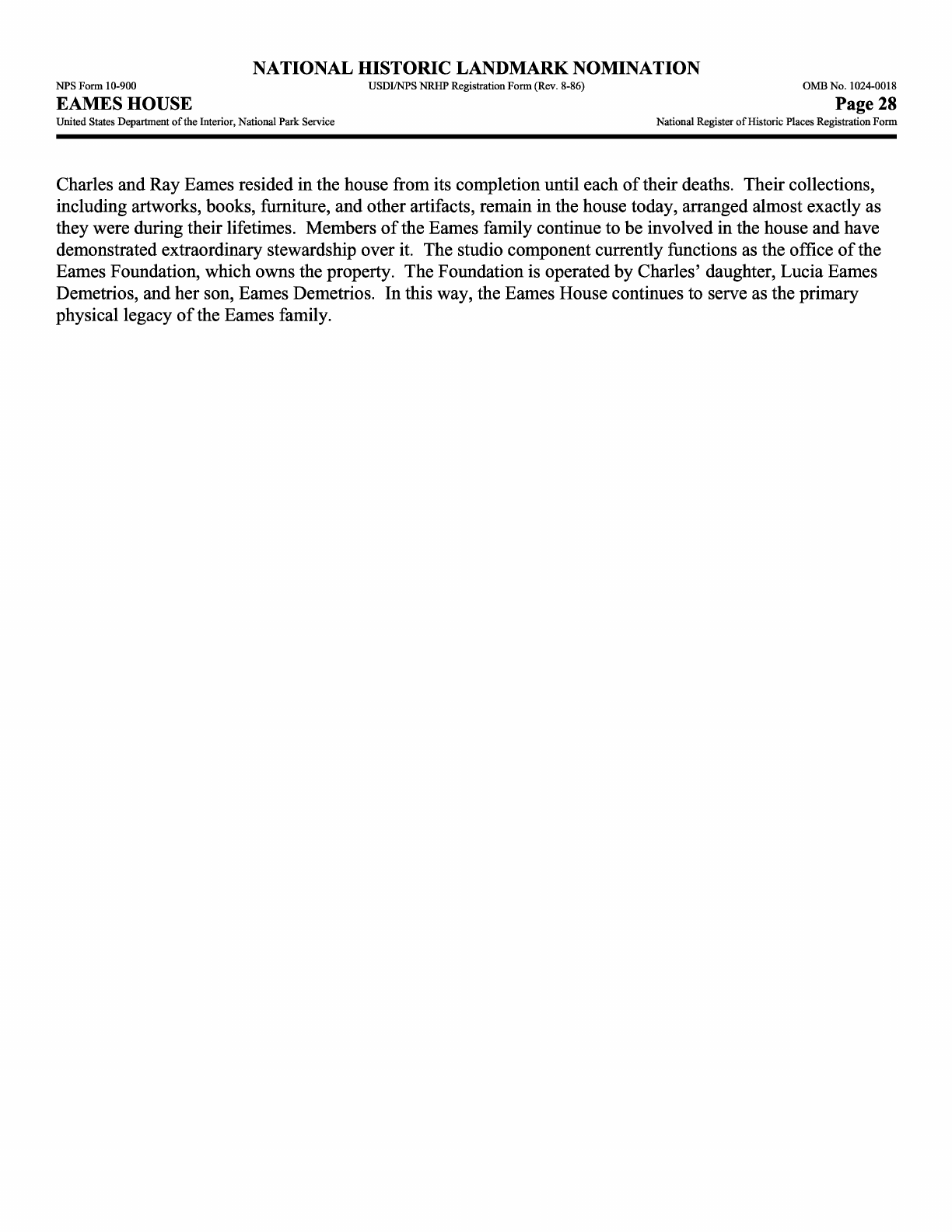
NATIONAL
HISTORIC
LANDMARK
NOMINATION
NFS
Form
10-900
USDI/NPS
NRHP
Registration
Form
(Rev.
8-86)
OMB
No.
1024-0018
EAMES
HOUSE
Page
28
United
States
Department
of
the
Interior,
National
Park
Service
National
Register
of
Historic
Places
Registration
Form
Charles
and Ray
Eames
resided
in
the
house
from
its
completion
until
each
of
their
deaths.
Their
collections,
including
artworks,
books,
furniture,
and
other
artifacts,
remain
in
the
house
today,
arranged
almost
exactly
as
they
were during
their
lifetimes.
Members
of
the
Eames
family
continue to
be
involved
in
the
house
and
have
demonstrated extraordinary
stewardship
over
it.
The
studio
component
currently
functions
as
the
office
of
the
Eames
Foundation,
which
owns
the
property.
The
Foundation
is
operated
by
Charles'
daughter,
Lucia
Eames
Demetrios,
and
her
son,
Eames
Demetrios.
In
this
way,
the
Eames
House continues
to
serve
as
the
primary
physical
legacy
of
the
Eames
family.
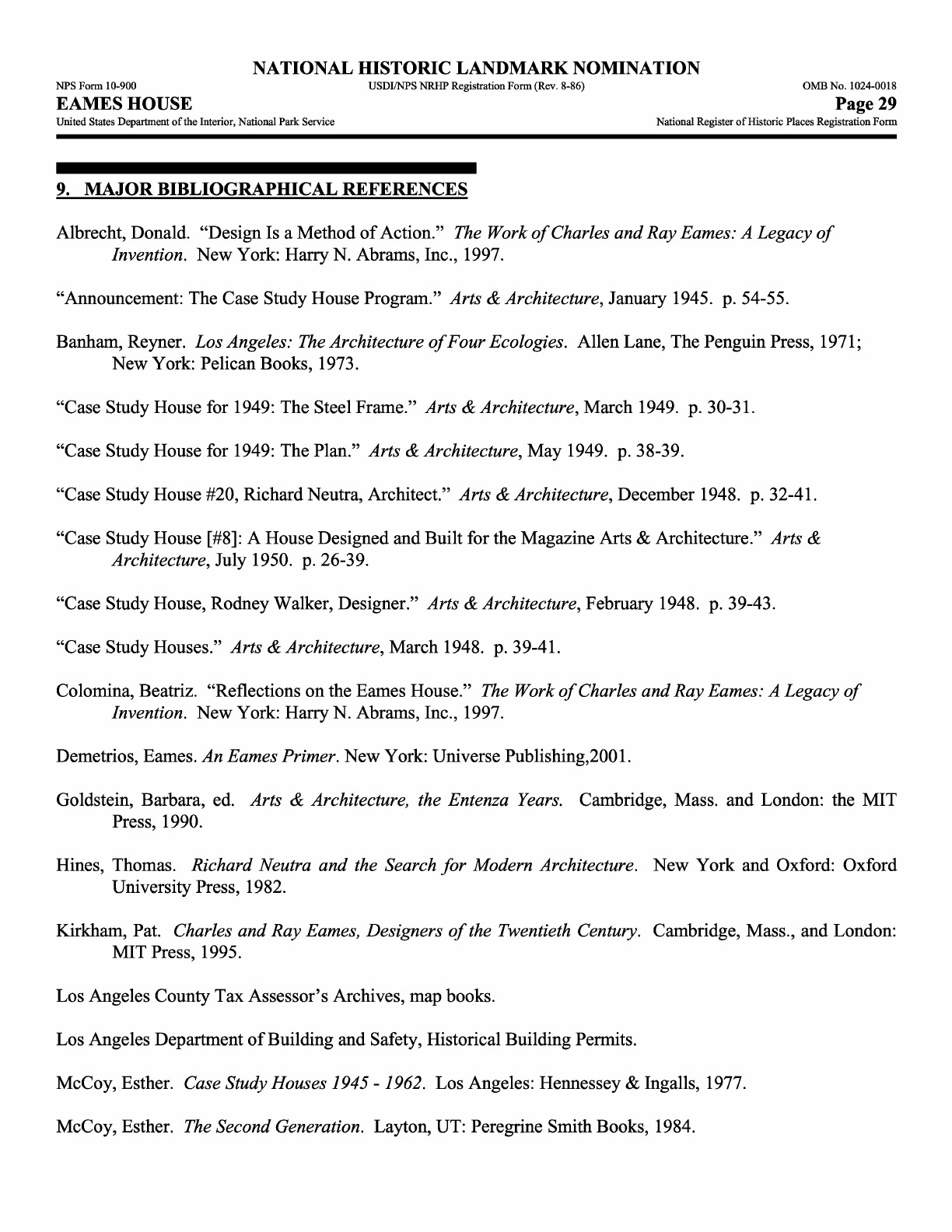
NATIONAL
HISTORIC
LANDMARK
NOMINATION
NFS
Form
10-900
USDI/NPS
NRHP
Registration
Form
(Rev.
8-86)
OMB
No.
1024-0018
EAMES
HOUSE
Page
29
United
States
Department
of
the
Interior,
National
Park
Service
National
Register
of
Historic
Places
Registration
Form
9.
MAJOR
BIBLIOGRAPHICAL
REFERENCES
Albrecht,
Donald.
"Design
Is
a
Method
of
Action."
The
Work
of
Charles
and
Ray
Fames:
A
Legacy
of
Invention.
New
York:
Harry
N.
Abrams,
Inc.,
1997.
"Announcement:
The
Case
Study
House
Program."
Arts
&
Architecture,
January
1945. p.
54-55.
Banham,
Reyner.
Los
Angeles:
The
Architecture
of
Four
Ecologies.
Alien
Lane, The
Penguin
Press,
1971;
New
York:
Pelican
Books,
1973.
"Case
Study
House
for
1949:
The
Steel
Frame."
Arts
&
Architecture,
March
1949.
p.
30-31.
"Case
Study
House
for
1949:
The
Plan."
Arts
&
Architecture,
May
1949.
p.
38-39.
"Case
Study
House
#20,
Richard
Neutra,
Architect."
Arts
&
Architecture,
December
1948. p.
32-41.
"Case
Study
House
[#8]:
A
House
Designed
and
Built
for
the
Magazine
Arts
&
Architecture."
Arts
&
Architecture,
July
1950.
p.
26-39.
"Case
Study
House,
Rodney
Walker,
Designer."
Arts
&
Architecture,
February
1948.
p.
39-43.
"Case
Study
Houses."
Arts
&
Architecture,
March
1948.
p.
39-41.
Colomina,
Beatriz.
"Reflections
on
the
Eames
House."
The
Work
of
Charles
and
Ray
Fames:
A
Legacy
of
Invention.
New
York:
Harry
N.
Abrams,
Inc.,
1997.
Demetrios,
Eames.
An
Eames
Primer.
New
York:
Universe
Publishing,2001.
Goldstein,
Barbara,
ed.
Arts
&
Architecture,
the
Entenza
Years.
Cambridge,
Mass,
and
London:
the
MIT
Press,
1990.
Hines, Thomas.
Richard
Neutra
and
the
Search
for
Modern
Architecture.
New
York
and
Oxford:
Oxford
University
Press,
1982.
Kirkham,
Pat.
Charles
and
Ray
Eames,
Designers
of
the
Twentieth
Century.
Cambridge,
Mass.,
and
London:
MIT
Press,
1995.
Los
Angeles
County Tax
Assessor's
Archives,
map
books.
Los
Angeles
Department
of
Building
and
Safety,
Historical
Building
Permits.
McCoy,
Esther.
Case
Study
Houses
1945
-1962.
Los
Angeles:
Hennessey
&
Ingalls,
1977.
McCoy,
Esther.
The
Second
Generation.
Layton,
UT:
Peregrine
Smith
Books,
1984.
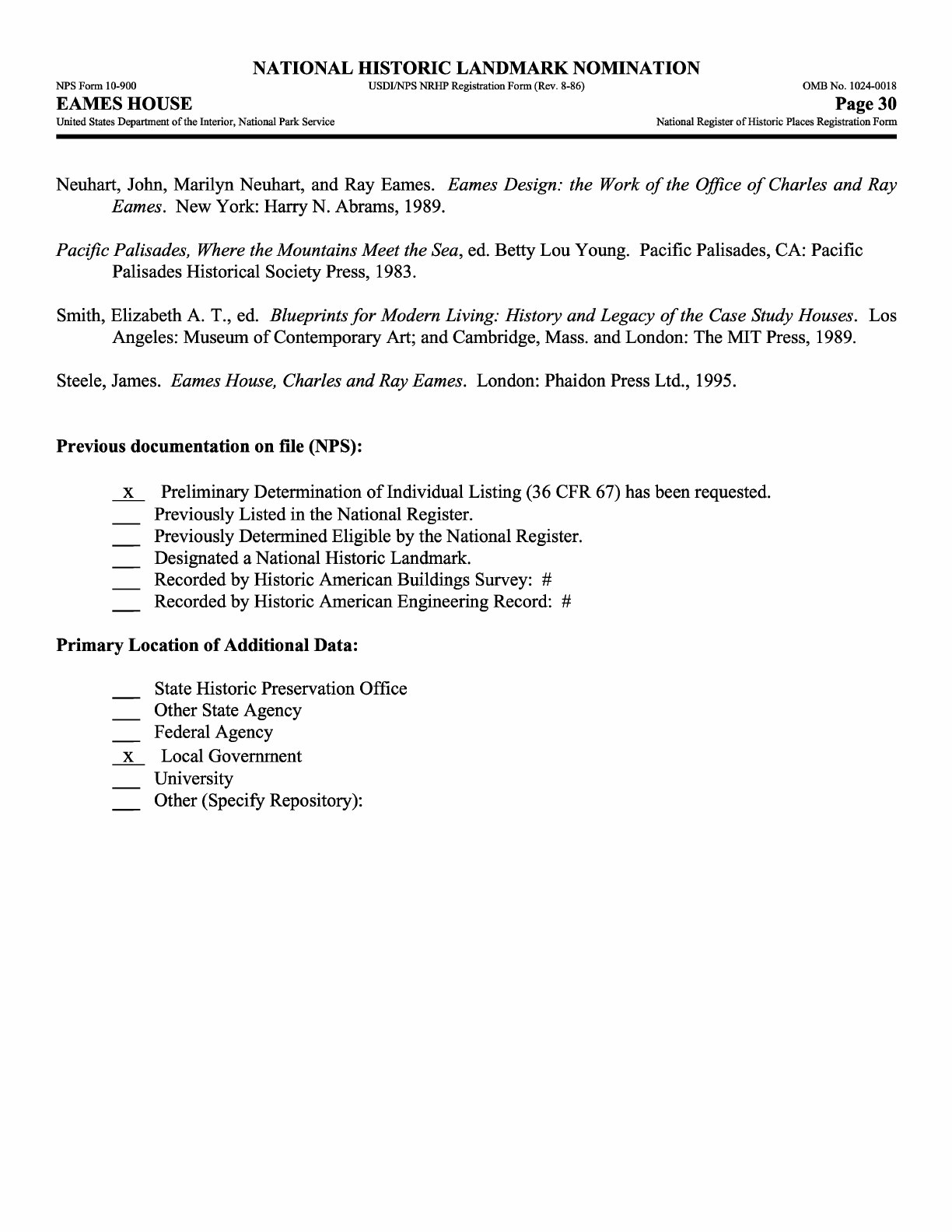
NATIONAL
HISTORIC
LANDMARK
NOMINATION
NFS
Form
10-900
USDI/NPS
NRHP
Registration
Form
(Rev.
8-86)
OMB
No.
1024-0018
EAMES
HOUSE
Page
30
United
States
Department
of
the
Interior,
National
Park
Service
National
Register
of
Historic
Places
Registration
Form
Neuhart,
John,
Marilyn
Neuhart,
and Ray
Eames.
Fames
Design:
the
Work
of
the
Office
of
Charles
and
Ray
Fames.
New
York:
Harry
N.
Abrams,
1989.
Pacific
Palisades,
Where
the
Mountains
Meet
the
Sea,
ed.
Betty
Lou
Young.
Pacific Palisades,
CA:
Pacific
Palisades
Historical
Society
Press,
1983.
Smith,
Elizabeth
A.
T.,
ed.
Blueprints
for
Modern
Living:
History
and
Legacy
of
the
Case
Study
Houses.
Los
Angeles:
Museum
of
Contemporary
Art;
and
Cambridge,
Mass,
and
London:
The
MIT
Press,
1989.
Steele,
James.
Eames
House,
Charles
and
Ray
Eames.
London:
Phaidon
Press
Ltd.,
1995.
Previous
documentation
on
file
(NPS):
x
Preliminary Determination
of
Individual
Listing
(36
CFR
67)
has
been
requested.
__
Previously
Listed
in
the
National
Register.
__
Previously
Determined
Eligible
by
the
National
Register.
__
Designated
a
National
Historic
Landmark.
__
Recorded
by
Historic
American
Buildings
Survey: #
__
Recorded
by
Historic
American Engineering
Record:
#
Primary
Location
of
Additional
Data:
State
Historic
Preservation
Office
Other
State
Agency
Federal
Agency
x
Local
Government
_
University
_
Other
(Specify
Repository):

NATIONAL
HISTORIC
LANDMARK
NOMINATION
NFS
Form
10-900
USDI/NPS
MRHP
Registration
Form
(Rev.
8-86)
OMB
No.
1024-0018
EAMES
HOUSE
Page
31
United
States
Department
of
the
Interior,
National
Park
Service
National
Register
of
Historic
Places
Registration
Form
10.
GEOGRAPHICAL
DATA
Acreage
of
Property:
1.4
acres
UTM
References:
Zone
Easting Northing
11
359758
3766051
Verbal
Boundary
Description:
The
subject
property
is
comprised
of
Tract
#13251,
Lot
1
(Assessor
Parcel
Number
4411-028-001).
The
property
is
bounded
by
Chautauqua
Boulevard
on
the
southeast;
the
lot
line
of
the
property
at
205
Chautauqua
Boulevard
(Tract
#13251,
Lot
2)
on
the
east/northeast;
Corona
del
Mar
on
the
northwest;
and
the
lot
lines
of
14841
W
Pacific
Coast
Highway
(Tract
#9473,
block
6,
lot
5)
and
14861
W
Pacific
Coast
Highway
(Tract
#6753,
block
6,
lot
4)
on
the
west/southwest.
The
site
measures approximately
1.4
acres
(60,794.7
square
feet).
Property boundaries
are
indicated
on
the
accompanying
map.
Boundary
Justification:
The
boundary
includes
the
original
house
and
studio
that
were
constructed
on
the
property
purchased
by
Charles
and Ray
Eames
from
John
Entenza
in
August
1948
and
that
maintain
historic
integrity.
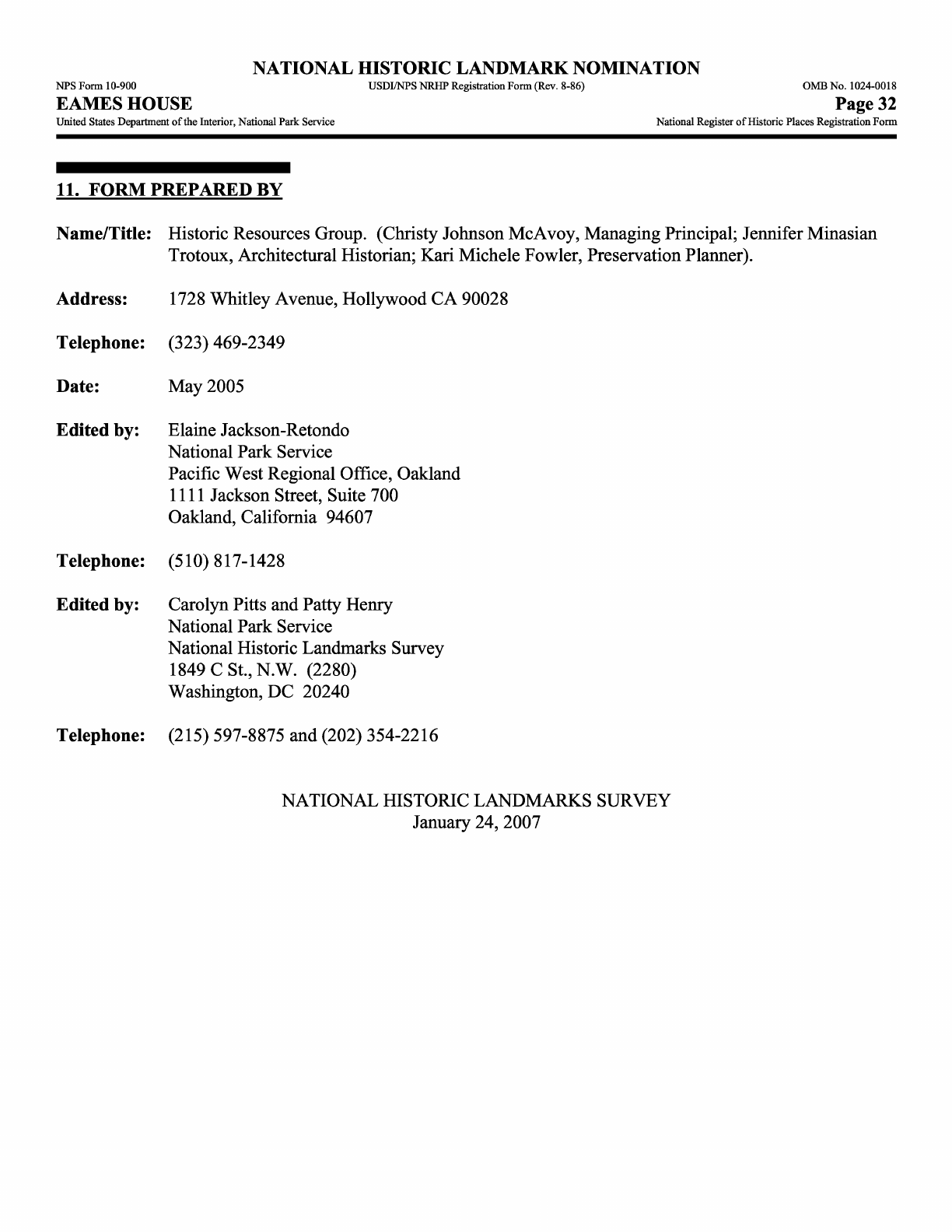
NFS
Form
10-900
EAMES
HOUSE
United
States
Department
of
the
Interior,
National
Park
Service
NATIONAL
HISTORIC
LANDMARK
NOMINATION
USDI/NPS
NRHP
Registration
Form
(Rev.
8-86)
OMB
No.
1024-0018
Page
32
National
Register
of
Historic
Places
Registration
Form
11.
FORM PREPARED
BY
Name/Title:
Historic
Resources
Group.
(Christy
Johnson
McAvoy,
Managing
Principal;
Jennifer
Minasian
Trotoux,
Architectural
Historian;
Kari
Michele
Fowler,
Preservation
Planner).
Address:
1728
Whitley
Avenue,
Hollywood
CA
90028
Telephone:
(323)
469-2349
Date:
May
2005
Edited
by:
Elaine
Jackson-Retondo
National
Park
Service
Pacific
West
Regional
Office,
Oakland
1111
Jackson
Street,
Suite
700
Oakland,
California
94607
Telephone:
(510)817-1428
Edited
by:
Carolyn
Pitts and
Patty
Henry
National
Park
Service
National
Historic
Landmarks
Survey
1849CSt,N.W.
(2280)
Washington,
DC
20240
Telephone: (215)
597-8875
and
(202)
354-2216
NATIONAL
HISTORIC
LANDMARKS
SURVEY
January
24,
2007
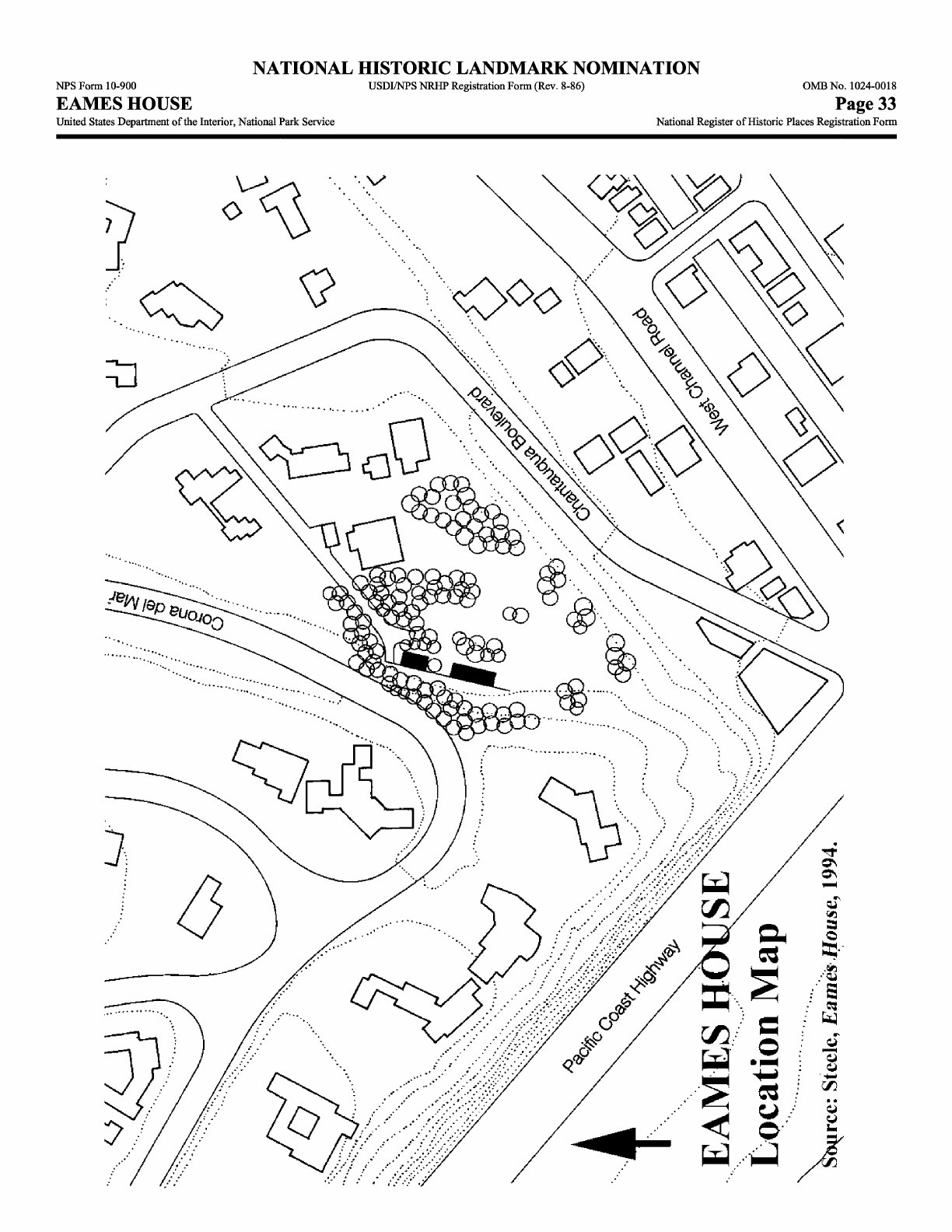
NFS
Form
10-900
EAMES
HOUSE
United
States
Department
of
the
Interior,
National
Park
Service
NATIONAL
HISTORIC
LANDMARK
NOMINATION
USDI/NPS
NRHP
Registration
Form
(Rev.
8-86)
OMB
No.
1024-0018
Page
33
National
Register
of
Historic
Places
Registration
Form
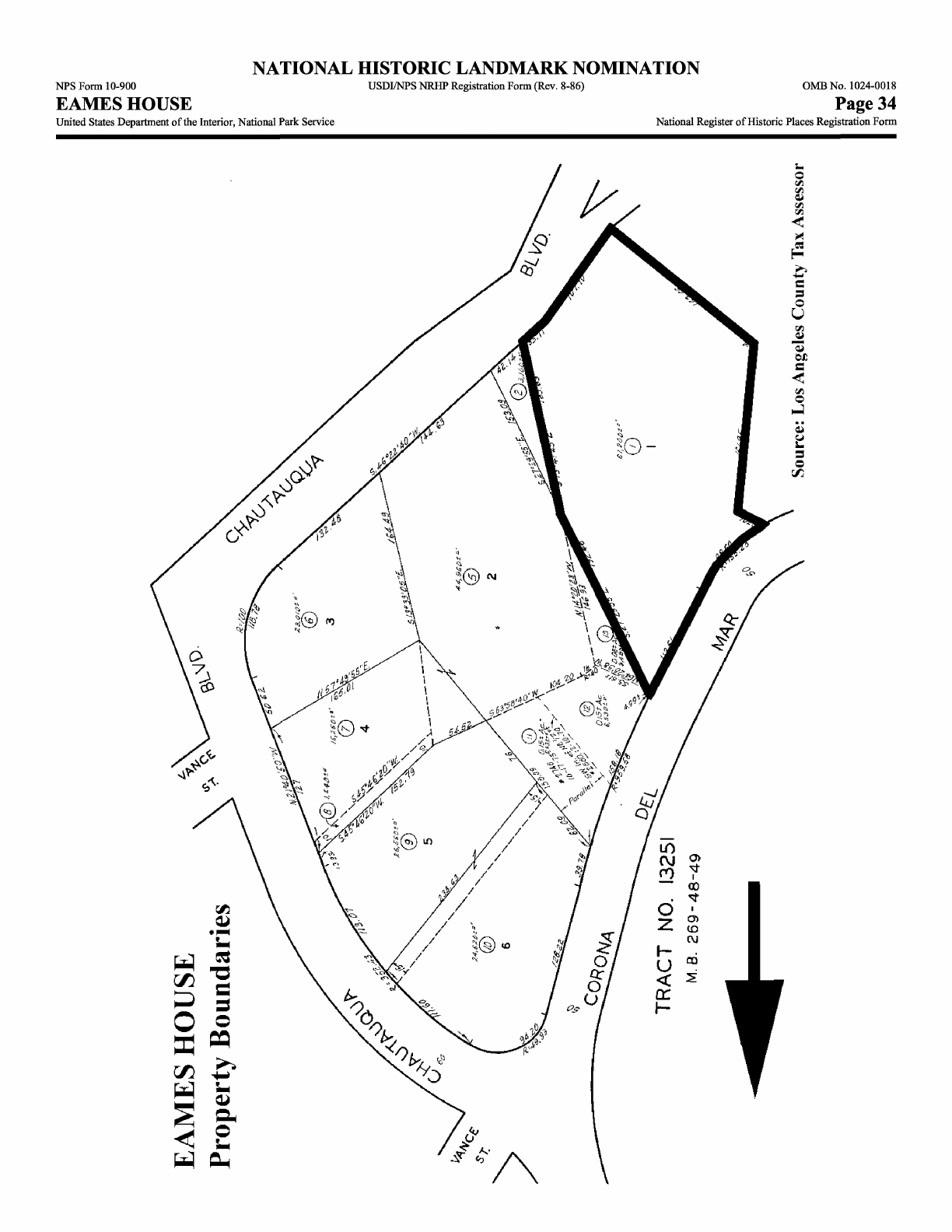
NFS
Form
10-900
EAMES
HOUSE
United
States
Department
of
the
Interior,
National
Park
Service
NATIONAL
HISTORIC
LANDMARK
NOMINATION
USDI/NPS
NRHP
Registration
Form
(Rev.
8-86)
OMB
No.
1024-0018
Page
34
National
Register
of
Historic
Places
Registration
Form
UJ
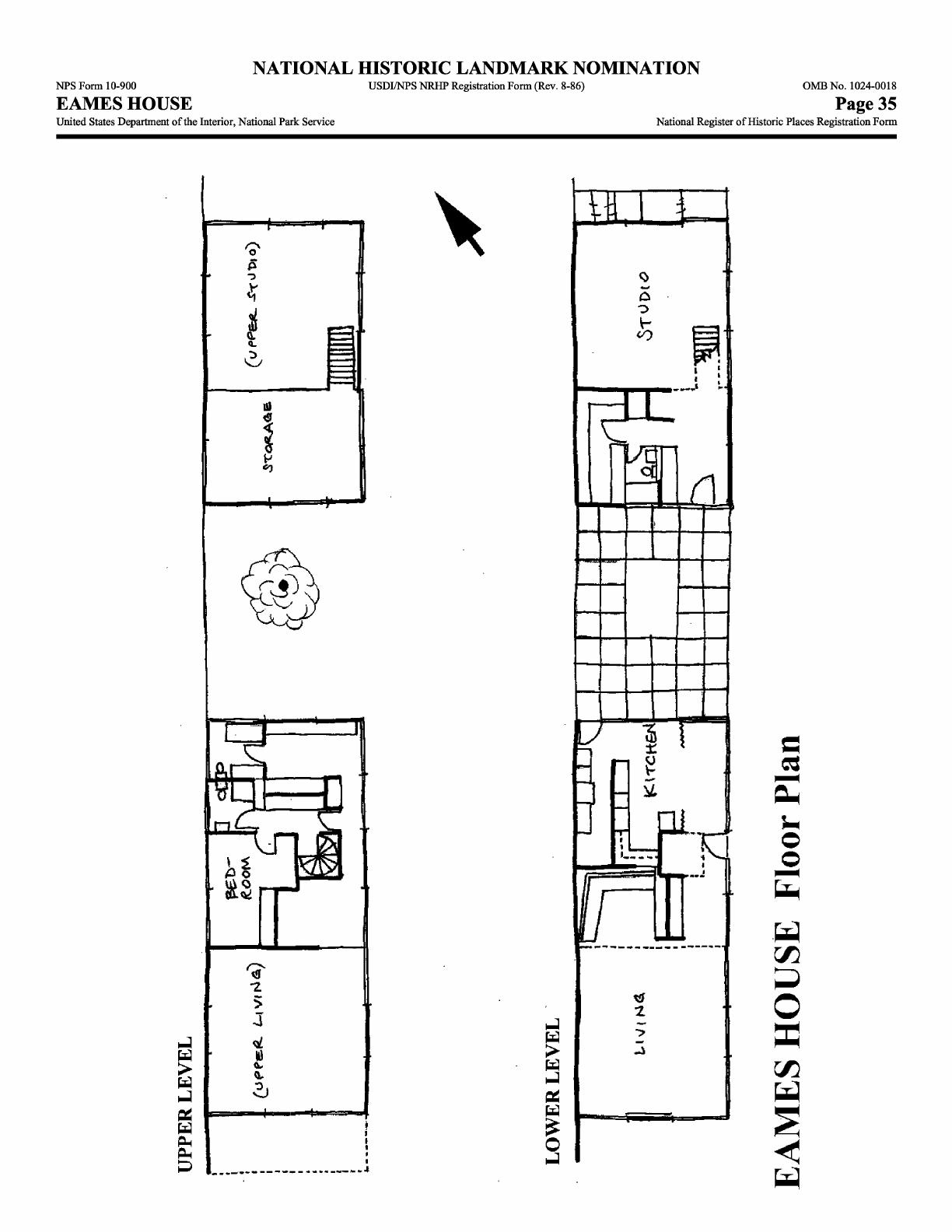
NFS
Form
10-900
EAMES
HOUSE
United
States
Department
of
the
Interior,
National
Park
Service
NATIONAL
HISTORIC
LANDMARK
NOMINATION
USDI/NPS
NRHP
Registration
Form
(Rev.
8-86)
OMB
No.
1024-0018
Page
35
National
Register
of
Historic
Places
Registration
Form
fc
PH
P
V
1EU
r
t^--
o
o
O
ffl

NATIONAL
HISTORIC
LANDMARK
NOMINATION
NFS
Form
10-900
USDI/NPS
NRHP
Registration
Form
(Rev.
8-86)
OMB
No.
1024-0018
EAMES
HOUSE
Page
36
United
States
Department
of
the
Interior,
National
Park
Service
National
Register
of
Historic
Places
Registration
Form
List
of
Black
and
White Photographs
No.
Description
View

NATIONAL
HISTORIC
LANDMARK
NOMINATION
NFS
Form
10-900
USDI/NPS
NRHP
Registration
Form
(Rev.
8-86)
OMB
No.
1024-0018
EAMES
HOUSE
Page
37
United
States
Department
of
the
Interior,
National
Park
Service
National
Register
of
Historic
Places
Registration
Form
List
of
Black
and
White Photographs,
continued.
No.
Description
View
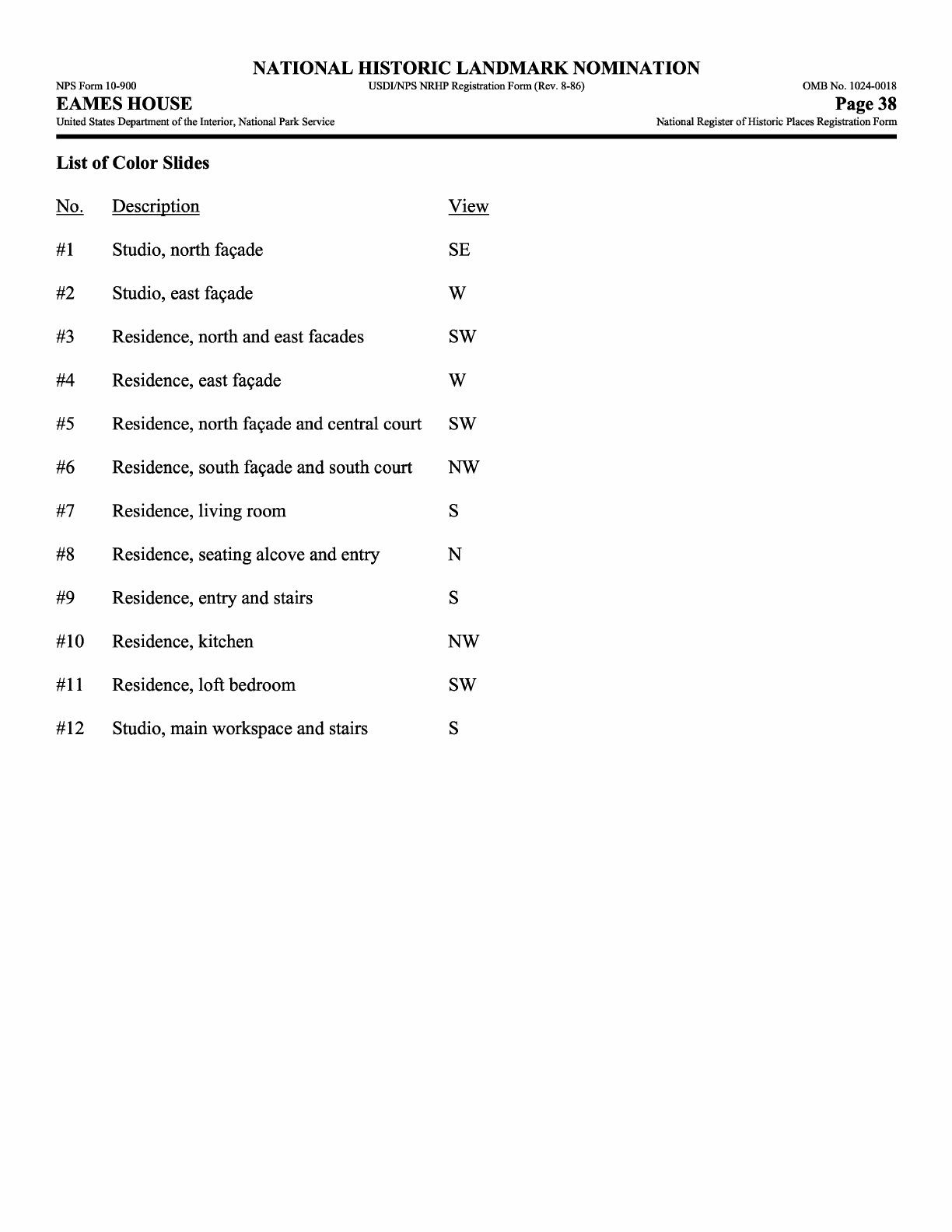
NFS
Form
10-900
EAMES
HOUSE
United
States
Department
of
the
Interior,
National
Park
Service
NATIONAL
HISTORIC
LANDMARK
NOMINATION
USDI/NPS
NRHP
Registration
Form
(Rev.
8-86)
OMB
No.
1024-0018
Page
38
National
Register
of
Historic
Places
Registration
Form
List
of
Color
Slides
No.
#1
#2
#3
#4
#5
#6
#1
#8
#9
#10
#11
#12
Description
Studio,
north
fa?ade
Studio,
east fa?ade
Residence,
north
and
east
facades
Residence,
east fa?ade
Residence,
north
fa?ade
and central
court
Residence,
south
fa?ade
and
south
court
Residence,
living
room
Residence,
seating
alcove
and
entry
Residence,
entry
and
stairs
Residence,
kitchen
Residence,
loft
bedroom
Studio,
main
workspace and
stairs
View
SE
W
SW
W
SW
NW
S
N
S
NW
SW
S
